Digital Media and Decline of Print Media: News Paper
VerifiedAdded on 2023/06/10
|41
|12850
|373
AI Summary
Digital media has become the reason behind the dearth of print media. This research aims to determine the effect of digital media on the decreasing popularity of print media. The study follows a qualitative analysis with case study analysis. The research objectives are to determine the strategy used by digital media platforms, the areas in which they excel, and the other factors that can affect the usage of print media platforms. The research hypothesis is that the decrease in the popularity of print media is due to the increasing usage of digital media among the population irrespective of their age.
Contribute Materials
Your contribution can guide someone’s learning journey. Share your
documents today.
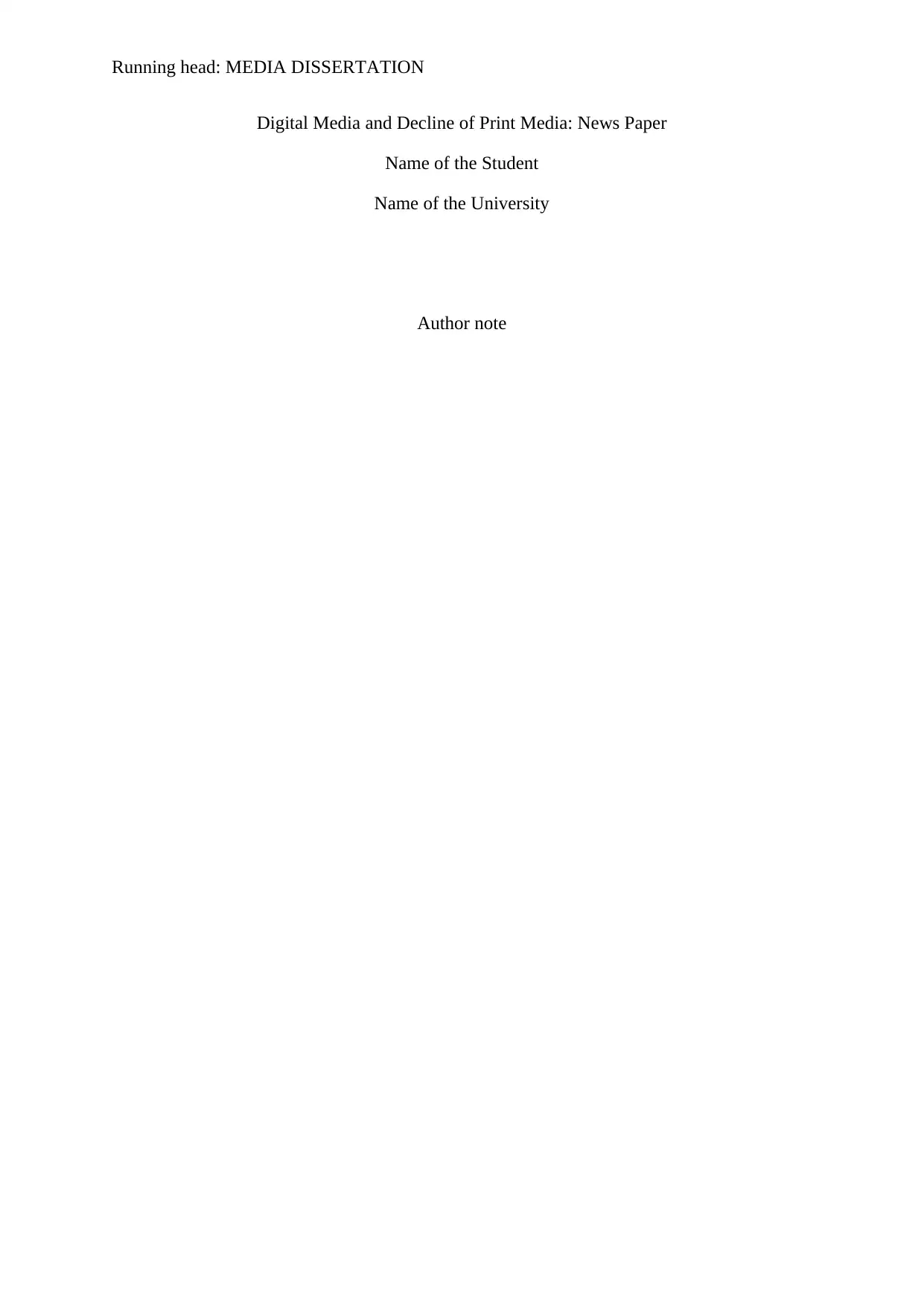
Running head: MEDIA DISSERTATION
Digital Media and Decline of Print Media: News Paper
Name of the Student
Name of the University
Author note
Digital Media and Decline of Print Media: News Paper
Name of the Student
Name of the University
Author note
Secure Best Marks with AI Grader
Need help grading? Try our AI Grader for instant feedback on your assignments.
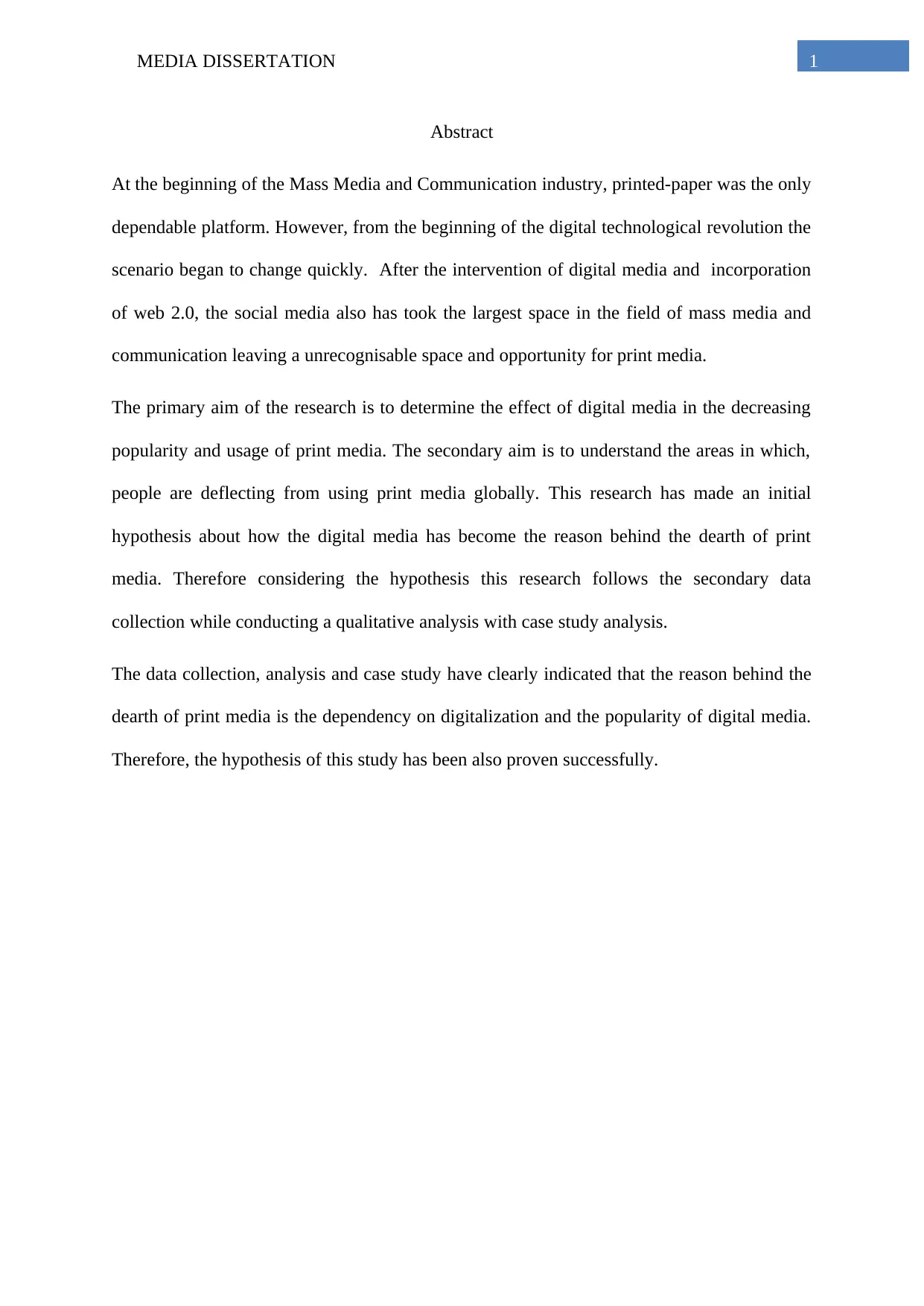
MEDIA DISSERTATION 1
Abstract
At the beginning of the Mass Media and Communication industry, printed-paper was the only
dependable platform. However, from the beginning of the digital technological revolution the
scenario began to change quickly. After the intervention of digital media and incorporation
of web 2.0, the social media also has took the largest space in the field of mass media and
communication leaving a unrecognisable space and opportunity for print media.
The primary aim of the research is to determine the effect of digital media in the decreasing
popularity and usage of print media. The secondary aim is to understand the areas in which,
people are deflecting from using print media globally. This research has made an initial
hypothesis about how the digital media has become the reason behind the dearth of print
media. Therefore considering the hypothesis this research follows the secondary data
collection while conducting a qualitative analysis with case study analysis.
The data collection, analysis and case study have clearly indicated that the reason behind the
dearth of print media is the dependency on digitalization and the popularity of digital media.
Therefore, the hypothesis of this study has been also proven successfully.
Abstract
At the beginning of the Mass Media and Communication industry, printed-paper was the only
dependable platform. However, from the beginning of the digital technological revolution the
scenario began to change quickly. After the intervention of digital media and incorporation
of web 2.0, the social media also has took the largest space in the field of mass media and
communication leaving a unrecognisable space and opportunity for print media.
The primary aim of the research is to determine the effect of digital media in the decreasing
popularity and usage of print media. The secondary aim is to understand the areas in which,
people are deflecting from using print media globally. This research has made an initial
hypothesis about how the digital media has become the reason behind the dearth of print
media. Therefore considering the hypothesis this research follows the secondary data
collection while conducting a qualitative analysis with case study analysis.
The data collection, analysis and case study have clearly indicated that the reason behind the
dearth of print media is the dependency on digitalization and the popularity of digital media.
Therefore, the hypothesis of this study has been also proven successfully.

MEDIA DISSERTATION 2
Table of content
Chapter 1: Introduction:.............................................................................................................4
1.1 Background of the study...................................................................................................4
1.2 Rationale of the study.......................................................................................................5
1.3 Research aim.....................................................................................................................6
1.4 Research Hypothesis..............................................................................................................6
1.4 Research objectives...........................................................................................................6
1.5 Structure of the study........................................................................................................7
Chapter 2: Literature review......................................................................................................8
2.1 Introduction............................................................................................................................8
2.2 History of Print media:..........................................................................................................9
2.3 Role of media and print media as a part of it:........................................................................9
2.4 The shift in the paradigm:....................................................................................................11
2.6 Theoretical analysis:............................................................................................................14
2.7 Intervention of digital Medias:............................................................................................16
2.8 Social Media and Communication:.....................................................................................17
2.9 Summary:.............................................................................................................................18
2.10 Literature gap:....................................................................................................................19
Chapter 3: Research methodology...........................................................................................20
3.1 Method outline.....................................................................................................................20
3.2 Research onion.....................................................................................................................20
Table of content
Chapter 1: Introduction:.............................................................................................................4
1.1 Background of the study...................................................................................................4
1.2 Rationale of the study.......................................................................................................5
1.3 Research aim.....................................................................................................................6
1.4 Research Hypothesis..............................................................................................................6
1.4 Research objectives...........................................................................................................6
1.5 Structure of the study........................................................................................................7
Chapter 2: Literature review......................................................................................................8
2.1 Introduction............................................................................................................................8
2.2 History of Print media:..........................................................................................................9
2.3 Role of media and print media as a part of it:........................................................................9
2.4 The shift in the paradigm:....................................................................................................11
2.6 Theoretical analysis:............................................................................................................14
2.7 Intervention of digital Medias:............................................................................................16
2.8 Social Media and Communication:.....................................................................................17
2.9 Summary:.............................................................................................................................18
2.10 Literature gap:....................................................................................................................19
Chapter 3: Research methodology...........................................................................................20
3.1 Method outline.....................................................................................................................20
3.2 Research onion.....................................................................................................................20
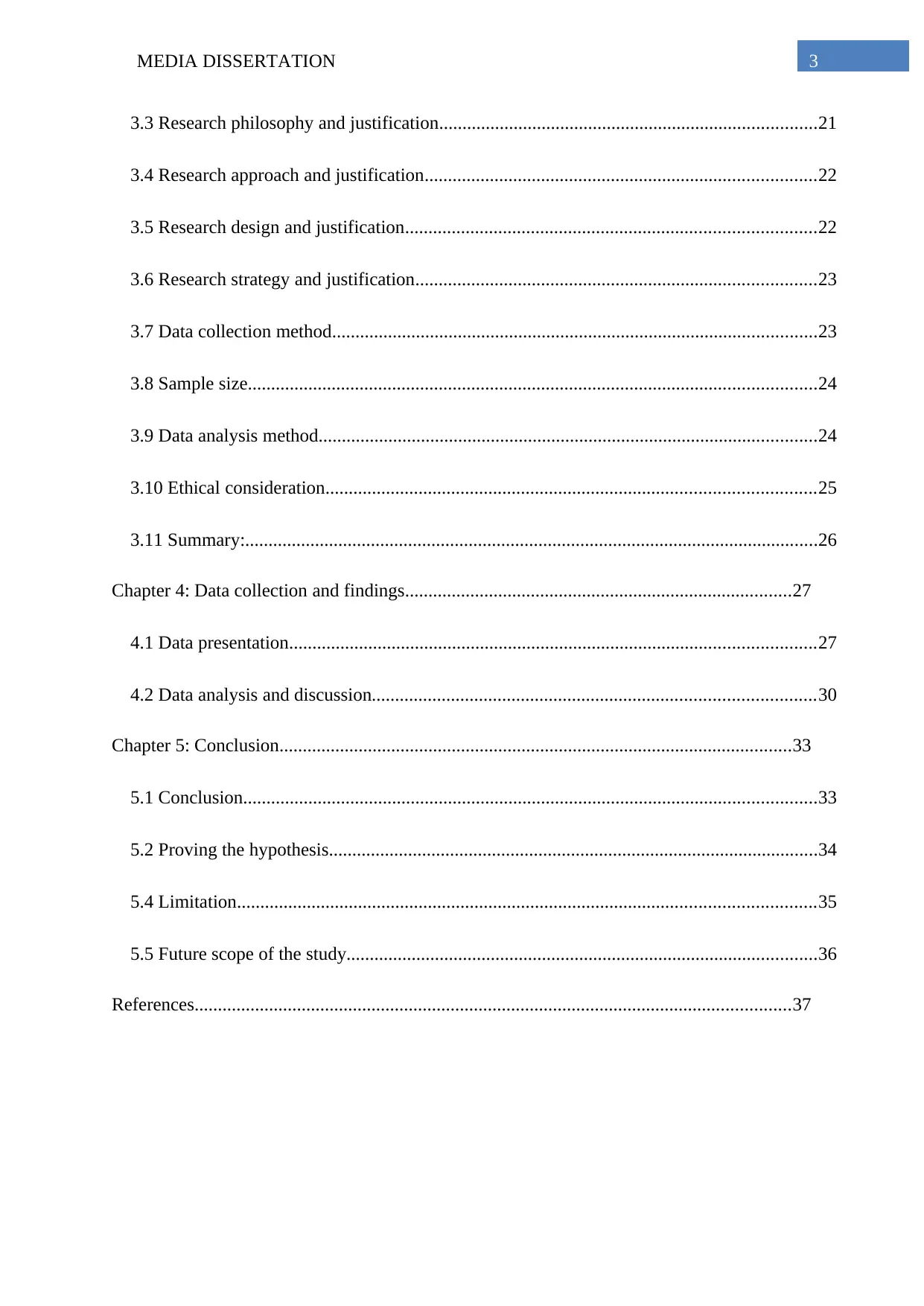
MEDIA DISSERTATION 3
3.3 Research philosophy and justification.................................................................................21
3.4 Research approach and justification....................................................................................22
3.5 Research design and justification........................................................................................22
3.6 Research strategy and justification......................................................................................23
3.7 Data collection method........................................................................................................23
3.8 Sample size..........................................................................................................................24
3.9 Data analysis method...........................................................................................................24
3.10 Ethical consideration.........................................................................................................25
3.11 Summary:...........................................................................................................................26
Chapter 4: Data collection and findings...................................................................................27
4.1 Data presentation.................................................................................................................27
4.2 Data analysis and discussion...............................................................................................30
Chapter 5: Conclusion..............................................................................................................33
5.1 Conclusion...........................................................................................................................33
5.2 Proving the hypothesis.........................................................................................................34
5.4 Limitation............................................................................................................................35
5.5 Future scope of the study.....................................................................................................36
References................................................................................................................................37
3.3 Research philosophy and justification.................................................................................21
3.4 Research approach and justification....................................................................................22
3.5 Research design and justification........................................................................................22
3.6 Research strategy and justification......................................................................................23
3.7 Data collection method........................................................................................................23
3.8 Sample size..........................................................................................................................24
3.9 Data analysis method...........................................................................................................24
3.10 Ethical consideration.........................................................................................................25
3.11 Summary:...........................................................................................................................26
Chapter 4: Data collection and findings...................................................................................27
4.1 Data presentation.................................................................................................................27
4.2 Data analysis and discussion...............................................................................................30
Chapter 5: Conclusion..............................................................................................................33
5.1 Conclusion...........................................................................................................................33
5.2 Proving the hypothesis.........................................................................................................34
5.4 Limitation............................................................................................................................35
5.5 Future scope of the study.....................................................................................................36
References................................................................................................................................37
Secure Best Marks with AI Grader
Need help grading? Try our AI Grader for instant feedback on your assignments.
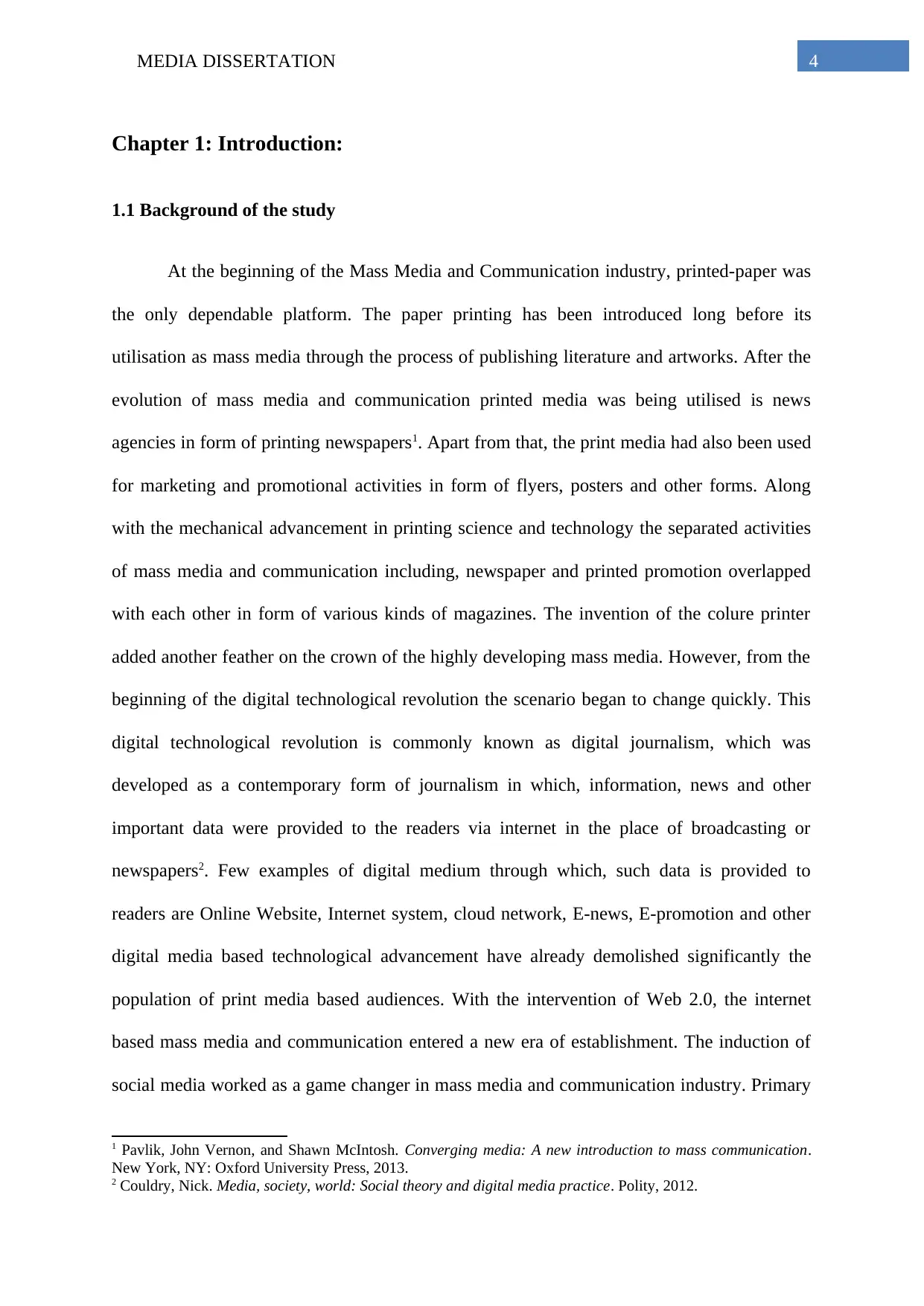
MEDIA DISSERTATION 4
Chapter 1: Introduction:
1.1 Background of the study
At the beginning of the Mass Media and Communication industry, printed-paper was
the only dependable platform. The paper printing has been introduced long before its
utilisation as mass media through the process of publishing literature and artworks. After the
evolution of mass media and communication printed media was being utilised is news
agencies in form of printing newspapers1. Apart from that, the print media had also been used
for marketing and promotional activities in form of flyers, posters and other forms. Along
with the mechanical advancement in printing science and technology the separated activities
of mass media and communication including, newspaper and printed promotion overlapped
with each other in form of various kinds of magazines. The invention of the colure printer
added another feather on the crown of the highly developing mass media. However, from the
beginning of the digital technological revolution the scenario began to change quickly. This
digital technological revolution is commonly known as digital journalism, which was
developed as a contemporary form of journalism in which, information, news and other
important data were provided to the readers via internet in the place of broadcasting or
newspapers2. Few examples of digital medium through which, such data is provided to
readers are Online Website, Internet system, cloud network, E-news, E-promotion and other
digital media based technological advancement have already demolished significantly the
population of print media based audiences. With the intervention of Web 2.0, the internet
based mass media and communication entered a new era of establishment. The induction of
social media worked as a game changer in mass media and communication industry. Primary
1 Pavlik, John Vernon, and Shawn McIntosh. Converging media: A new introduction to mass communication.
New York, NY: Oxford University Press, 2013.
2 Couldry, Nick. Media, society, world: Social theory and digital media practice. Polity, 2012.
Chapter 1: Introduction:
1.1 Background of the study
At the beginning of the Mass Media and Communication industry, printed-paper was
the only dependable platform. The paper printing has been introduced long before its
utilisation as mass media through the process of publishing literature and artworks. After the
evolution of mass media and communication printed media was being utilised is news
agencies in form of printing newspapers1. Apart from that, the print media had also been used
for marketing and promotional activities in form of flyers, posters and other forms. Along
with the mechanical advancement in printing science and technology the separated activities
of mass media and communication including, newspaper and printed promotion overlapped
with each other in form of various kinds of magazines. The invention of the colure printer
added another feather on the crown of the highly developing mass media. However, from the
beginning of the digital technological revolution the scenario began to change quickly. This
digital technological revolution is commonly known as digital journalism, which was
developed as a contemporary form of journalism in which, information, news and other
important data were provided to the readers via internet in the place of broadcasting or
newspapers2. Few examples of digital medium through which, such data is provided to
readers are Online Website, Internet system, cloud network, E-news, E-promotion and other
digital media based technological advancement have already demolished significantly the
population of print media based audiences. With the intervention of Web 2.0, the internet
based mass media and communication entered a new era of establishment. The induction of
social media worked as a game changer in mass media and communication industry. Primary
1 Pavlik, John Vernon, and Shawn McIntosh. Converging media: A new introduction to mass communication.
New York, NY: Oxford University Press, 2013.
2 Couldry, Nick. Media, society, world: Social theory and digital media practice. Polity, 2012.

MEDIA DISSERTATION 5
reason of the holistic spread of digital media platform throughout the world was ease of
creativity and presentation that provided journalists to explore their unique ideas, which was
restricted in print as well as broadcasting media3. Further, it also provides the reader with
ease of gaining knowledge and distributes within a second to a larger population of readers,
hence increasing its reach to a larger population.
1.2 Rationale of the study
The current press media throughout the world is facing a decline or deep crisis that is
affecting the business of such media houses. As per the data of World Association of
Newspapers magazine, the number of readers of newspapers is decreasing constantly as the
people have started reading news on their phones. This has created a competition for the
printed media options as the number of readers are shifting from print media to digital media
because of its easy availability. In Singapore, the newspaper organization Singapore Today
conducted a survey in 2013 that determined that the number of people reading the newspaper
dropped by 145,000 readerships that constitutes to the loss of 14.3%. Therefore, the primary
reason for conducting this research was to identify the issues and reasons due to which, the
emergence of digital media is creating challenges for print media houses. Further, another
justification for conducting this study will be inability of the press media to maintain in
reputation in Singapore, whereas, in China and Britain Print media is still the best source to
get any news. Therefore, the rationale for the research will be identifying the actions print
media has taken is those countries, which the Singapore print media is unable to take to save
its reputation and reader base.
3 Wimmer, Roger D., and Joseph R. Dominick. Mass media research. Cengage learning, 2013.
reason of the holistic spread of digital media platform throughout the world was ease of
creativity and presentation that provided journalists to explore their unique ideas, which was
restricted in print as well as broadcasting media3. Further, it also provides the reader with
ease of gaining knowledge and distributes within a second to a larger population of readers,
hence increasing its reach to a larger population.
1.2 Rationale of the study
The current press media throughout the world is facing a decline or deep crisis that is
affecting the business of such media houses. As per the data of World Association of
Newspapers magazine, the number of readers of newspapers is decreasing constantly as the
people have started reading news on their phones. This has created a competition for the
printed media options as the number of readers are shifting from print media to digital media
because of its easy availability. In Singapore, the newspaper organization Singapore Today
conducted a survey in 2013 that determined that the number of people reading the newspaper
dropped by 145,000 readerships that constitutes to the loss of 14.3%. Therefore, the primary
reason for conducting this research was to identify the issues and reasons due to which, the
emergence of digital media is creating challenges for print media houses. Further, another
justification for conducting this study will be inability of the press media to maintain in
reputation in Singapore, whereas, in China and Britain Print media is still the best source to
get any news. Therefore, the rationale for the research will be identifying the actions print
media has taken is those countries, which the Singapore print media is unable to take to save
its reputation and reader base.
3 Wimmer, Roger D., and Joseph R. Dominick. Mass media research. Cengage learning, 2013.
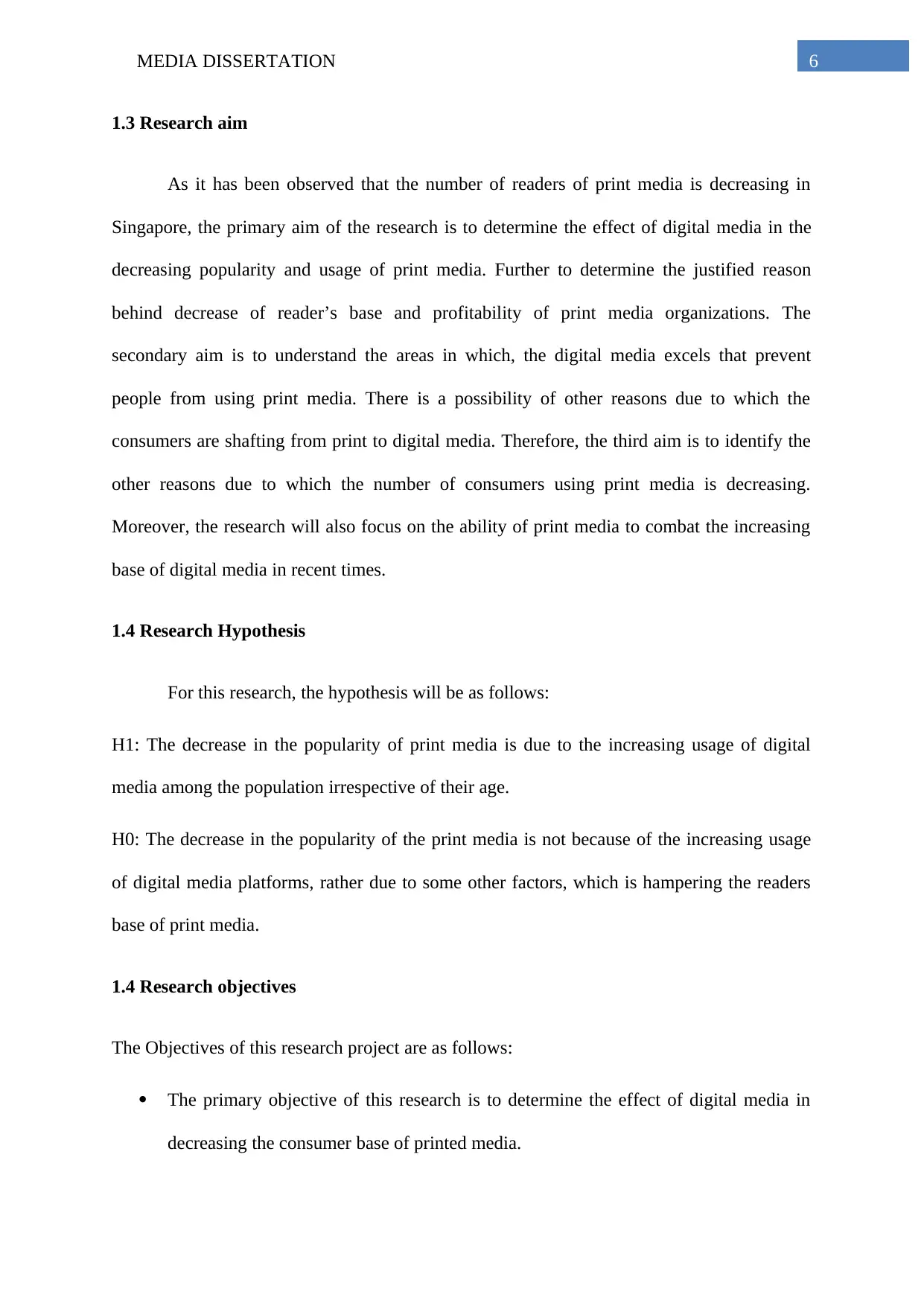
MEDIA DISSERTATION 6
1.3 Research aim
As it has been observed that the number of readers of print media is decreasing in
Singapore, the primary aim of the research is to determine the effect of digital media in the
decreasing popularity and usage of print media. Further to determine the justified reason
behind decrease of reader’s base and profitability of print media organizations. The
secondary aim is to understand the areas in which, the digital media excels that prevent
people from using print media. There is a possibility of other reasons due to which the
consumers are shafting from print to digital media. Therefore, the third aim is to identify the
other reasons due to which the number of consumers using print media is decreasing.
Moreover, the research will also focus on the ability of print media to combat the increasing
base of digital media in recent times.
1.4 Research Hypothesis
For this research, the hypothesis will be as follows:
H1: The decrease in the popularity of print media is due to the increasing usage of digital
media among the population irrespective of their age.
H0: The decrease in the popularity of the print media is not because of the increasing usage
of digital media platforms, rather due to some other factors, which is hampering the readers
base of print media.
1.4 Research objectives
The Objectives of this research project are as follows:
The primary objective of this research is to determine the effect of digital media in
decreasing the consumer base of printed media.
1.3 Research aim
As it has been observed that the number of readers of print media is decreasing in
Singapore, the primary aim of the research is to determine the effect of digital media in the
decreasing popularity and usage of print media. Further to determine the justified reason
behind decrease of reader’s base and profitability of print media organizations. The
secondary aim is to understand the areas in which, the digital media excels that prevent
people from using print media. There is a possibility of other reasons due to which the
consumers are shafting from print to digital media. Therefore, the third aim is to identify the
other reasons due to which the number of consumers using print media is decreasing.
Moreover, the research will also focus on the ability of print media to combat the increasing
base of digital media in recent times.
1.4 Research Hypothesis
For this research, the hypothesis will be as follows:
H1: The decrease in the popularity of print media is due to the increasing usage of digital
media among the population irrespective of their age.
H0: The decrease in the popularity of the print media is not because of the increasing usage
of digital media platforms, rather due to some other factors, which is hampering the readers
base of print media.
1.4 Research objectives
The Objectives of this research project are as follows:
The primary objective of this research is to determine the effect of digital media in
decreasing the consumer base of printed media.
Paraphrase This Document
Need a fresh take? Get an instant paraphrase of this document with our AI Paraphraser

MEDIA DISSERTATION 7
To determine the strategy used by digital media platforms or the areas in which they
excel, that make readers shift from print media platform to digital media platform.
The third objective will be to determine the other factors that can also affect the usage
of print media platforms, if it is not affected due to the increasing consumers of digital
media platforms.
1.5 Structure of the study
Research structure is the outline of the entire research, which is used to enlist the
complete research components. The structure of this research will constitute abstract, in
which the concise detail of the entire research has been included. Further, a detailed
introduction has been included which contains the background\d details of the study, its
rationale, the research aims, objectives and the hypothesis depending on which the findings
of the research will be categorized. Further, a detailed methodology will also be included.
Using two case studies related to the research topic, the data of print media and digital media
would be provided, which further will be analyzed and interpreted in the later section.
Finally, a conclusion, limitation of the study and the future prospect of the research will be
included so that the gaps of this research can be identified.
IntroductionLiteratureReviewResearchMethodlogyDatapresentation5.AnalysisandinterpretationConclusionandRecommenation
To determine the strategy used by digital media platforms or the areas in which they
excel, that make readers shift from print media platform to digital media platform.
The third objective will be to determine the other factors that can also affect the usage
of print media platforms, if it is not affected due to the increasing consumers of digital
media platforms.
1.5 Structure of the study
Research structure is the outline of the entire research, which is used to enlist the
complete research components. The structure of this research will constitute abstract, in
which the concise detail of the entire research has been included. Further, a detailed
introduction has been included which contains the background\d details of the study, its
rationale, the research aims, objectives and the hypothesis depending on which the findings
of the research will be categorized. Further, a detailed methodology will also be included.
Using two case studies related to the research topic, the data of print media and digital media
would be provided, which further will be analyzed and interpreted in the later section.
Finally, a conclusion, limitation of the study and the future prospect of the research will be
included so that the gaps of this research can be identified.
IntroductionLiteratureReviewResearchMethodlogyDatapresentation5.AnalysisandinterpretationConclusionandRecommenation

MEDIA DISSERTATION 8
Chapter 2: Literature review
2.1 Introduction
It is not in few years mass media has started to being affected. The mass media has
begun getting influenced with the technologies long before the internet or social media, it is
precisely the print media that has been affected. The print media refers to newspaper,
magazines, journals, periodicals and books. Earlier, the role of media was performed only
through the publishing houses through the mentioned components4. The printing press was
the only instrument of production that was used to produce millions of copies of newspaper,
flyers, books and magazines. The primary significance of the print media is to spread
knowledge and ideas in the mass. Initially, the printing used to be through the handwritten
process that consumed a lengthy amount of time to produce a single book5. However, the
changes did not take long to occur along with the other significant changes, and through
industrialization, the mass media industry also experienced enormous changes. The initial
stages of print media were influenced by developed machinery followed by electronic media
such as television and radio. Television and radio have brought vivid changes in the media
industry primarily the changing the readership habit of the population. The revolution by
modern digital and electronic media is presenting the advance and developed stage of mass
media6. The new generation has undoubtedly given improved versions of providing
information to people, however, in the process of development, there is a segment of the mass
media that is on the verge of passing away. The changes and advances in the technology and
the internet in the last ten years have reshaped the way information and knowledge are
4Hsia, Hower J. Mass communications research methods: A step-by-step approach. Routledge, 2015.
5Okigbo, Charles, and GoranHyden."The media and the two waves of democracy."In Media and democracy in
Africa, pp. 29-53.Routledge, 2017.
6Brown, James A. Television', Critical Viewing Skills', Education: Major Media Literacy Projects in the United
States and Selected Countries. Routledge, 2013.
Chapter 2: Literature review
2.1 Introduction
It is not in few years mass media has started to being affected. The mass media has
begun getting influenced with the technologies long before the internet or social media, it is
precisely the print media that has been affected. The print media refers to newspaper,
magazines, journals, periodicals and books. Earlier, the role of media was performed only
through the publishing houses through the mentioned components4. The printing press was
the only instrument of production that was used to produce millions of copies of newspaper,
flyers, books and magazines. The primary significance of the print media is to spread
knowledge and ideas in the mass. Initially, the printing used to be through the handwritten
process that consumed a lengthy amount of time to produce a single book5. However, the
changes did not take long to occur along with the other significant changes, and through
industrialization, the mass media industry also experienced enormous changes. The initial
stages of print media were influenced by developed machinery followed by electronic media
such as television and radio. Television and radio have brought vivid changes in the media
industry primarily the changing the readership habit of the population. The revolution by
modern digital and electronic media is presenting the advance and developed stage of mass
media6. The new generation has undoubtedly given improved versions of providing
information to people, however, in the process of development, there is a segment of the mass
media that is on the verge of passing away. The changes and advances in the technology and
the internet in the last ten years have reshaped the way information and knowledge are
4Hsia, Hower J. Mass communications research methods: A step-by-step approach. Routledge, 2015.
5Okigbo, Charles, and GoranHyden."The media and the two waves of democracy."In Media and democracy in
Africa, pp. 29-53.Routledge, 2017.
6Brown, James A. Television', Critical Viewing Skills', Education: Major Media Literacy Projects in the United
States and Selected Countries. Routledge, 2013.

MEDIA DISSERTATION 9
aggregated, transformed, and disseminated7. The print media which was the initial stage of
mass media is slowly losing its significance in the digital age and is not preferred by the
audience in this contemporary era, therefore, it is clearly seen that the print media is on the
decline.
2.2 History of Print media:
The method of producing images and texts to spread information and knowledge was
first done in China before 220 A.D. The Chinese were the first to invent the art of printing
and made it on wooden blocks to print letters. During the Tang Dynasty, the printing process
was started in 600 AD8. Also, the first book that was published was in China in 868 AD. It
was the Egyptians who invented paper around 3500 BC, and it arrived in Spain, Europe in the
11th century. The printing technology is believed to be developed by a German, Johannes
Gutenberg around 14399. He also invented an oil-based ink for printing and printed the Bible
in 1450. Later, the process of printing was adopted by the whole world, and now it has
become impossible to imagine a world without paper and print. The invention of printing has
played a significant role in the development of the Renaissance and the scientific revolution.
2.3 Role of media and print media as a part of it:
Media-industry is a vital sector for any region for the contribution it makes towards
society. Print media is of various types, and it includes magazines, brochures, posters,
banners and lastly the newspapers. The leading role that print media has been playing is the
offering of extensive news, information and in-depth treatment of themes. They are the
provider of the more abundant variety of coverage through the medium of different types of
7Cukier, Kenneth, and Viktor Mayer-Schoenberger. "The rise of big data: How it's changing the way we think
about the world." Foreign Aff. 92 (2013): 28.
8Mun, Seung-Hwan. "Printing press without copyright: a historical analysis of printing and publishing in Song,
China." Chinese Journal of Communication 6, no. 1 (2013): 1-23.
9Straubhaar, Joseph, Robert LaRose, and Lucinda Davenport.Media now: Understanding media, culture, and
technology. Cengage Learning, 2013.
aggregated, transformed, and disseminated7. The print media which was the initial stage of
mass media is slowly losing its significance in the digital age and is not preferred by the
audience in this contemporary era, therefore, it is clearly seen that the print media is on the
decline.
2.2 History of Print media:
The method of producing images and texts to spread information and knowledge was
first done in China before 220 A.D. The Chinese were the first to invent the art of printing
and made it on wooden blocks to print letters. During the Tang Dynasty, the printing process
was started in 600 AD8. Also, the first book that was published was in China in 868 AD. It
was the Egyptians who invented paper around 3500 BC, and it arrived in Spain, Europe in the
11th century. The printing technology is believed to be developed by a German, Johannes
Gutenberg around 14399. He also invented an oil-based ink for printing and printed the Bible
in 1450. Later, the process of printing was adopted by the whole world, and now it has
become impossible to imagine a world without paper and print. The invention of printing has
played a significant role in the development of the Renaissance and the scientific revolution.
2.3 Role of media and print media as a part of it:
Media-industry is a vital sector for any region for the contribution it makes towards
society. Print media is of various types, and it includes magazines, brochures, posters,
banners and lastly the newspapers. The leading role that print media has been playing is the
offering of extensive news, information and in-depth treatment of themes. They are the
provider of the more abundant variety of coverage through the medium of different types of
7Cukier, Kenneth, and Viktor Mayer-Schoenberger. "The rise of big data: How it's changing the way we think
about the world." Foreign Aff. 92 (2013): 28.
8Mun, Seung-Hwan. "Printing press without copyright: a historical analysis of printing and publishing in Song,
China." Chinese Journal of Communication 6, no. 1 (2013): 1-23.
9Straubhaar, Joseph, Robert LaRose, and Lucinda Davenport.Media now: Understanding media, culture, and
technology. Cengage Learning, 2013.
Secure Best Marks with AI Grader
Need help grading? Try our AI Grader for instant feedback on your assignments.

MEDIA DISSERTATION 10
writings10. There are separate sections devoted to the different genre, including daily affairs,
sports, politics, awareness, business, entertainment and exclusive articles. It also has designed
columns for reviews of book, films, media and art. The newspaper helps readers become
responsible and informed citizen. Since media is used intensively by the mass, it is a vast
platform for advertisement. Traditionally the media performed its functions in a more
straightforward way and offered the above mentioned components. Later, with the electronic
media, things appeared in a different form. The electronic media are the electronic device that
operates with the electrical energy for obtaining information and entertainment. The
electronic media has been dominating the media industry since its inception by providing
instantaneous news and entertainment. They are considered to be the primary source of news.
The information provided by the media has a role to play in the shaping ideas and
sensibilities, and therefore it has a burden of responsibility11. The newspaper serves society in
various ways, it prints in different languages and segregates in separate sections for people to
choose as per their choice. Almost every person is depended on the media for information
which makes it an absolute necessity. Media is not merely a carrier of news; it lets people
access to worldwide information sitting at home. After the electronic and digital invention
people preferred the television and the radio over the newspaper. It has been the dominating
form of media for the most prolonged period however with the growing technology the
digital media is now becoming another favourite source of information. People are now
slowly shifting is on the digital as it is a most comfortable way of following up with the news
anywhere and anytime.
10Alam, Abdullah, and Syed Zulfiqar Ali Shah. "The role of press freedom in economic development: A global
perspective." Journal of Media Economics 26, no. 1 (2013): 4-20.
11Happer, Catherine, and Greg Philo."The role of the media in the construction of public belief and social
change."Journal of social and political psychology 1, no. 1 (2013): 321-336.
writings10. There are separate sections devoted to the different genre, including daily affairs,
sports, politics, awareness, business, entertainment and exclusive articles. It also has designed
columns for reviews of book, films, media and art. The newspaper helps readers become
responsible and informed citizen. Since media is used intensively by the mass, it is a vast
platform for advertisement. Traditionally the media performed its functions in a more
straightforward way and offered the above mentioned components. Later, with the electronic
media, things appeared in a different form. The electronic media are the electronic device that
operates with the electrical energy for obtaining information and entertainment. The
electronic media has been dominating the media industry since its inception by providing
instantaneous news and entertainment. They are considered to be the primary source of news.
The information provided by the media has a role to play in the shaping ideas and
sensibilities, and therefore it has a burden of responsibility11. The newspaper serves society in
various ways, it prints in different languages and segregates in separate sections for people to
choose as per their choice. Almost every person is depended on the media for information
which makes it an absolute necessity. Media is not merely a carrier of news; it lets people
access to worldwide information sitting at home. After the electronic and digital invention
people preferred the television and the radio over the newspaper. It has been the dominating
form of media for the most prolonged period however with the growing technology the
digital media is now becoming another favourite source of information. People are now
slowly shifting is on the digital as it is a most comfortable way of following up with the news
anywhere and anytime.
10Alam, Abdullah, and Syed Zulfiqar Ali Shah. "The role of press freedom in economic development: A global
perspective." Journal of Media Economics 26, no. 1 (2013): 4-20.
11Happer, Catherine, and Greg Philo."The role of the media in the construction of public belief and social
change."Journal of social and political psychology 1, no. 1 (2013): 321-336.

MEDIA DISSERTATION 11
2.4 The shift in the paradigm:
The changes and advances in the technology and the internet in the last ten years have
reshaped the way information and knowledge are aggregated, transformed, and
disseminated12. Whether it is in print, Television, radio or digital devices, it is evident that it
reaches a broad audience often covering national as well as international. In the coming
years, the reality is expected to be without the existence of print media. The decline of print
media has been discussed and debated widely. In recent years the industry of print media is
faced with many challenges since it is a traditional method of media and many new
technologies have emerged with the industrial revolution13. For a very long time, print media
has provided information, knowledge and entertainment in its beautiful way. Print media, in
its static nature, allowed indefinite exposure. People would read beautiful magazines with
visually attractive photos and interesting content in leisure times. Also, people could always
store the articles or photos if found useful and print media gave the opportunity to come back
and re-read the same thing several times when wished to do so. However, people’s way of
gathering information took a turn when the industrialisation produced the broadcast media14.
The first shift was made in the 1950s with the emergence of television and radio. After the
development of television and radio, two continuous decades at the beginning of the
innovation happened to affect the printing industry drastically. The device with audio and
visual entertainment attracted the audience at an instance. Although radio could not give the
visual entertainment, it offers ongoing dialogue, actions and background music. This quality
allows making a high impact on audiences and keeps the audience hooked. Television helps
reaching nationwide audience and radio helps to reach the local audiences. Since the
12Nielsen, RasmusKleis. Local journalism: The decline of newspapers and the rise of digital media. IB Tauris,
2015.
13Doyle, Gillian. "Re-invention and survival: newspapers in the era of digital multiplatform delivery." Journal of
Media Business Studies 10, no. 4 (2013): 1-20.
14Karimi, Jahangir, and Zhiping Walter. "The role of dynamic capabilities in responding to digital disruption: A
factor-based study of the newspaper industry." Journal of Management Information Systems 32, no. 1 (2015):
39-81.
2.4 The shift in the paradigm:
The changes and advances in the technology and the internet in the last ten years have
reshaped the way information and knowledge are aggregated, transformed, and
disseminated12. Whether it is in print, Television, radio or digital devices, it is evident that it
reaches a broad audience often covering national as well as international. In the coming
years, the reality is expected to be without the existence of print media. The decline of print
media has been discussed and debated widely. In recent years the industry of print media is
faced with many challenges since it is a traditional method of media and many new
technologies have emerged with the industrial revolution13. For a very long time, print media
has provided information, knowledge and entertainment in its beautiful way. Print media, in
its static nature, allowed indefinite exposure. People would read beautiful magazines with
visually attractive photos and interesting content in leisure times. Also, people could always
store the articles or photos if found useful and print media gave the opportunity to come back
and re-read the same thing several times when wished to do so. However, people’s way of
gathering information took a turn when the industrialisation produced the broadcast media14.
The first shift was made in the 1950s with the emergence of television and radio. After the
development of television and radio, two continuous decades at the beginning of the
innovation happened to affect the printing industry drastically. The device with audio and
visual entertainment attracted the audience at an instance. Although radio could not give the
visual entertainment, it offers ongoing dialogue, actions and background music. This quality
allows making a high impact on audiences and keeps the audience hooked. Television helps
reaching nationwide audience and radio helps to reach the local audiences. Since the
12Nielsen, RasmusKleis. Local journalism: The decline of newspapers and the rise of digital media. IB Tauris,
2015.
13Doyle, Gillian. "Re-invention and survival: newspapers in the era of digital multiplatform delivery." Journal of
Media Business Studies 10, no. 4 (2013): 1-20.
14Karimi, Jahangir, and Zhiping Walter. "The role of dynamic capabilities in responding to digital disruption: A
factor-based study of the newspaper industry." Journal of Management Information Systems 32, no. 1 (2015):
39-81.
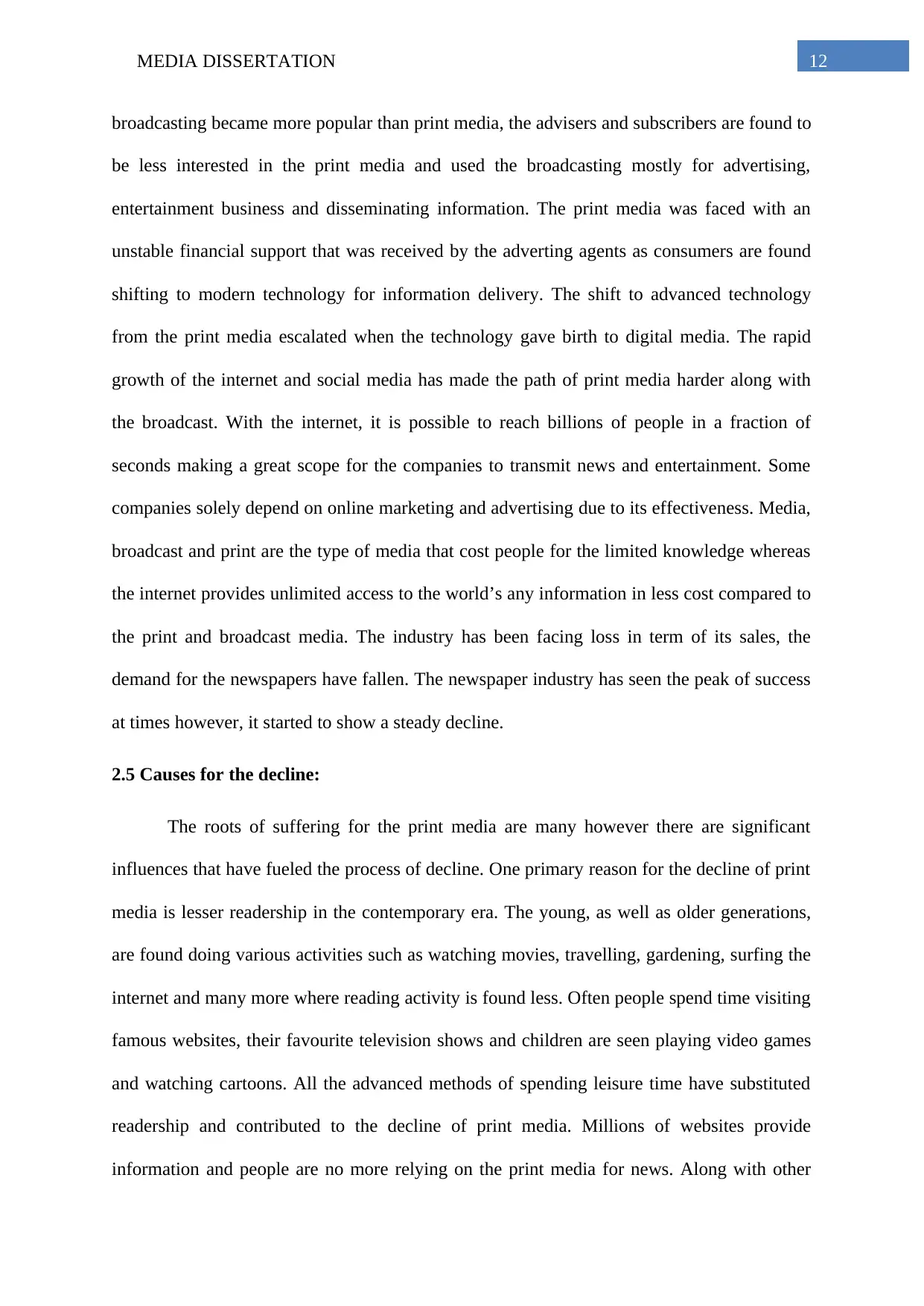
MEDIA DISSERTATION 12
broadcasting became more popular than print media, the advisers and subscribers are found to
be less interested in the print media and used the broadcasting mostly for advertising,
entertainment business and disseminating information. The print media was faced with an
unstable financial support that was received by the adverting agents as consumers are found
shifting to modern technology for information delivery. The shift to advanced technology
from the print media escalated when the technology gave birth to digital media. The rapid
growth of the internet and social media has made the path of print media harder along with
the broadcast. With the internet, it is possible to reach billions of people in a fraction of
seconds making a great scope for the companies to transmit news and entertainment. Some
companies solely depend on online marketing and advertising due to its effectiveness. Media,
broadcast and print are the type of media that cost people for the limited knowledge whereas
the internet provides unlimited access to the world’s any information in less cost compared to
the print and broadcast media. The industry has been facing loss in term of its sales, the
demand for the newspapers have fallen. The newspaper industry has seen the peak of success
at times however, it started to show a steady decline.
2.5 Causes for the decline:
The roots of suffering for the print media are many however there are significant
influences that have fueled the process of decline. One primary reason for the decline of print
media is lesser readership in the contemporary era. The young, as well as older generations,
are found doing various activities such as watching movies, travelling, gardening, surfing the
internet and many more where reading activity is found less. Often people spend time visiting
famous websites, their favourite television shows and children are seen playing video games
and watching cartoons. All the advanced methods of spending leisure time have substituted
readership and contributed to the decline of print media. Millions of websites provide
information and people are no more relying on the print media for news. Along with other
broadcasting became more popular than print media, the advisers and subscribers are found to
be less interested in the print media and used the broadcasting mostly for advertising,
entertainment business and disseminating information. The print media was faced with an
unstable financial support that was received by the adverting agents as consumers are found
shifting to modern technology for information delivery. The shift to advanced technology
from the print media escalated when the technology gave birth to digital media. The rapid
growth of the internet and social media has made the path of print media harder along with
the broadcast. With the internet, it is possible to reach billions of people in a fraction of
seconds making a great scope for the companies to transmit news and entertainment. Some
companies solely depend on online marketing and advertising due to its effectiveness. Media,
broadcast and print are the type of media that cost people for the limited knowledge whereas
the internet provides unlimited access to the world’s any information in less cost compared to
the print and broadcast media. The industry has been facing loss in term of its sales, the
demand for the newspapers have fallen. The newspaper industry has seen the peak of success
at times however, it started to show a steady decline.
2.5 Causes for the decline:
The roots of suffering for the print media are many however there are significant
influences that have fueled the process of decline. One primary reason for the decline of print
media is lesser readership in the contemporary era. The young, as well as older generations,
are found doing various activities such as watching movies, travelling, gardening, surfing the
internet and many more where reading activity is found less. Often people spend time visiting
famous websites, their favourite television shows and children are seen playing video games
and watching cartoons. All the advanced methods of spending leisure time have substituted
readership and contributed to the decline of print media. Millions of websites provide
information and people are no more relying on the print media for news. Along with other
Paraphrase This Document
Need a fresh take? Get an instant paraphrase of this document with our AI Paraphraser

MEDIA DISSERTATION 13
social and global issues, one primary concern has been the environmental concerns. The
production of printing presses creates substantial environmental pollution while discharging
harmful chemicals. People working in the industry is found to be the victim of severe health
hazards like asthma which as a result make the job seekers give the print media industry
lesser preference15.
Expenses are seen as another cause for the failure of printing media. The print media
certainly has more costs when compared to the other forms of media. The types of machinery
involved in the producing millions of copies are expensive, and when the income is
rationalised, it does not generate revenue as much as the expenditure. Also, the most cost-
effective as well as an easy way of gathering information for the consumers is the other
media sources. The newspapers and magazines are distributed door-to-door, or it is purchased
from the nearest store. The printing industry needs a different section of recruitment where
the job of distributing the newspaper is performed. The easier job is by the other media
forms, the digital and broadcast media that are available sitting at home. Therefore, the whole
process of producing overnight journals and distributing door-to-door in the morning is very
time-consuming. The print media fails to provide give people the privilege of giving instant
news. The digital and broadcast are way much faster than the print media, and people always
tend to go for the faster source of information16. The quantity of information in the
newspapers and other print media sources are limited to the few pages highlighting only the
favourite topics such as politics, sports, business and films. The scope of providing a better
quantity of information is little higher in the broadcast media making the internet in the first
position giving people the opportunity to access unlimited information on unlimited topics.
15Rothmann, Wasko, and Jochen Koch. "Creativity in strategic lock-ins: The newspaper industry and the digital
revolution." Technological Forecasting and Social Change 83 (2014): 66-83.
16Athey, Susan, Emilio Calvano, and Joshua Gans.The impact of the internet on advertising markets for news
media. No. w19419.National Bureau of Economic Research, 2013.
social and global issues, one primary concern has been the environmental concerns. The
production of printing presses creates substantial environmental pollution while discharging
harmful chemicals. People working in the industry is found to be the victim of severe health
hazards like asthma which as a result make the job seekers give the print media industry
lesser preference15.
Expenses are seen as another cause for the failure of printing media. The print media
certainly has more costs when compared to the other forms of media. The types of machinery
involved in the producing millions of copies are expensive, and when the income is
rationalised, it does not generate revenue as much as the expenditure. Also, the most cost-
effective as well as an easy way of gathering information for the consumers is the other
media sources. The newspapers and magazines are distributed door-to-door, or it is purchased
from the nearest store. The printing industry needs a different section of recruitment where
the job of distributing the newspaper is performed. The easier job is by the other media
forms, the digital and broadcast media that are available sitting at home. Therefore, the whole
process of producing overnight journals and distributing door-to-door in the morning is very
time-consuming. The print media fails to provide give people the privilege of giving instant
news. The digital and broadcast are way much faster than the print media, and people always
tend to go for the faster source of information16. The quantity of information in the
newspapers and other print media sources are limited to the few pages highlighting only the
favourite topics such as politics, sports, business and films. The scope of providing a better
quantity of information is little higher in the broadcast media making the internet in the first
position giving people the opportunity to access unlimited information on unlimited topics.
15Rothmann, Wasko, and Jochen Koch. "Creativity in strategic lock-ins: The newspaper industry and the digital
revolution." Technological Forecasting and Social Change 83 (2014): 66-83.
16Athey, Susan, Emilio Calvano, and Joshua Gans.The impact of the internet on advertising markets for news
media. No. w19419.National Bureau of Economic Research, 2013.

MEDIA DISSERTATION 14
2.6 Theoretical analysis:
Authoritarian theory: according to this theory, all types of communications are under
the control of the governing authorities as well as authorities or influential bureaucrats. The
powerful section of the society has strong hold on the mass communications. This theory
explains that the authoritarians are a necessary body that is needed to prevent the people and
to protect the nation from any kind of threats from any communication and information17.
Some of the news that is sensitive to certain group of people or the whole nation is needed to
be checked so it does not create any sort of threat to the nation. The mass media has the
access to reach millions of people at an instant and therefore it has the power to influence
people easily. It is an instrument that is used to enhance the ruler’s power in the state and not
create any threats. The authorities hold the power to permit media to release information by
means of license that will provide guidance regarding the matters. When any media is found
violating the government rules and regulation, the authorities can cancel the license and
revoke it. The authorities mainly focus on controlling the distribution of any sensitive issues
that can raise misbalance and problem in maintain the harmony. It determines maintaining
peace, order and security in the nation.
An act of suppression of any kind of communication that may seem harmful to the
people, government, authorities or nation is called censorship. These censorship methods are
recognized by media and they can identify the communications that are against the freedom
of expression and freedom of speech. In many cases the rulers and authorities are helped from
sensitive issues. There are different forms of censors such as political censors, religious
censors, moral censors and corporate censors.
Libertarian theory: according to libertarian theory, people are seen as the sole
judgment maker of good ideas and bad ideas. This theory identifies people as rational bodies
17McNair, Brian. An introduction to political communication.Routledge, 2017.
2.6 Theoretical analysis:
Authoritarian theory: according to this theory, all types of communications are under
the control of the governing authorities as well as authorities or influential bureaucrats. The
powerful section of the society has strong hold on the mass communications. This theory
explains that the authoritarians are a necessary body that is needed to prevent the people and
to protect the nation from any kind of threats from any communication and information17.
Some of the news that is sensitive to certain group of people or the whole nation is needed to
be checked so it does not create any sort of threat to the nation. The mass media has the
access to reach millions of people at an instant and therefore it has the power to influence
people easily. It is an instrument that is used to enhance the ruler’s power in the state and not
create any threats. The authorities hold the power to permit media to release information by
means of license that will provide guidance regarding the matters. When any media is found
violating the government rules and regulation, the authorities can cancel the license and
revoke it. The authorities mainly focus on controlling the distribution of any sensitive issues
that can raise misbalance and problem in maintain the harmony. It determines maintaining
peace, order and security in the nation.
An act of suppression of any kind of communication that may seem harmful to the
people, government, authorities or nation is called censorship. These censorship methods are
recognized by media and they can identify the communications that are against the freedom
of expression and freedom of speech. In many cases the rulers and authorities are helped from
sensitive issues. There are different forms of censors such as political censors, religious
censors, moral censors and corporate censors.
Libertarian theory: according to libertarian theory, people are seen as the sole
judgment maker of good ideas and bad ideas. This theory identifies people as rational bodies
17McNair, Brian. An introduction to political communication.Routledge, 2017.

MEDIA DISSERTATION 15
who can decide what information is pleasant and unpleasant. The press should not be
restricted from spreading knowledge even when it is a negative content since criticism helps
in evolving from bad situation. The libertarian theory is certainly opposite of the authoritarian
theory which keeps the king or the state above all18. As the name suggest, liberalism means
information is the key to knowledge and knowledge is the ultimate power; libertarian theory
is based on freedom of press from any authority or any control. However, there are some
advantages as well as disadvantages of this this theory. The freedom of media will make
press free from the control and it will disclose genuine things occurring in the society without
any limitation. It will give more value to people’s thought and help them express it to media.
However, the theory is seen as an absolute positive theory which is impractical in nature.
Perhaps the media can release information that can hurt the sentiments of people and can
damage the harmony.
Social responsibility theory: this particular theory lies between the authoritarian
theory and libertarian theory where there is no boundary for the press however at the same
time it needs to display its content in public panel and it needs to accept any sort of obligation
from professional self-regulation as well as public interference. The only control that is
exerted is the external control19. This theory has helped in bringing professionalism in media
by setting up a high standardization based on truth, accuracy and informative. The Social
responsibility theoryformulates the code of conduct and make penalty for violating the code
of conduct. Avoiding any kind of conflict situation during emergency and war by taking the
public opinion has been made possible through this theory.
The soviet media theory: based on Marxist and Lenin principles the soviet media
theory is structured. The soviet media theory follows the model of Leninist principles which
18DeFleur, Melvin L., and Margaret H. DeFleur.Mass communication theories: Explaining origins, processes,
and effects. Routledge, 2016.
19Thompson, John B. Ideology and modern culture: Critical social theory in the era of mass communication.
John Wiley & Sons, 2013.
who can decide what information is pleasant and unpleasant. The press should not be
restricted from spreading knowledge even when it is a negative content since criticism helps
in evolving from bad situation. The libertarian theory is certainly opposite of the authoritarian
theory which keeps the king or the state above all18. As the name suggest, liberalism means
information is the key to knowledge and knowledge is the ultimate power; libertarian theory
is based on freedom of press from any authority or any control. However, there are some
advantages as well as disadvantages of this this theory. The freedom of media will make
press free from the control and it will disclose genuine things occurring in the society without
any limitation. It will give more value to people’s thought and help them express it to media.
However, the theory is seen as an absolute positive theory which is impractical in nature.
Perhaps the media can release information that can hurt the sentiments of people and can
damage the harmony.
Social responsibility theory: this particular theory lies between the authoritarian
theory and libertarian theory where there is no boundary for the press however at the same
time it needs to display its content in public panel and it needs to accept any sort of obligation
from professional self-regulation as well as public interference. The only control that is
exerted is the external control19. This theory has helped in bringing professionalism in media
by setting up a high standardization based on truth, accuracy and informative. The Social
responsibility theoryformulates the code of conduct and make penalty for violating the code
of conduct. Avoiding any kind of conflict situation during emergency and war by taking the
public opinion has been made possible through this theory.
The soviet media theory: based on Marxist and Lenin principles the soviet media
theory is structured. The soviet media theory follows the model of Leninist principles which
18DeFleur, Melvin L., and Margaret H. DeFleur.Mass communication theories: Explaining origins, processes,
and effects. Routledge, 2016.
19Thompson, John B. Ideology and modern culture: Critical social theory in the era of mass communication.
John Wiley & Sons, 2013.
Secure Best Marks with AI Grader
Need help grading? Try our AI Grader for instant feedback on your assignments.

MEDIA DISSERTATION 16
is based on the Karl Marx and Engel’s ideology. According to this theory, the government
regulates control on the media and serves the working class20. The major interest of theory is
to use the media and communication is to keep the interest of the working class maintained.
Government has the absolute power to access control on any media for the benefit of the
working class and the purpose of the media is to educate the large masses of working class.
The theory is similar to the authoritarian theory however the core part is what makes it
different and this theory can even go wrong if the leader of the nation is selected wrong.
With all the theories in mind, it can be stated undoubtedly that the press is getting
adapted to the libertarian theory. There is very little control by the authorities and the
controlling agents on the digital media. The print media can be controlled by the government
easily and that is one reason people seek for information in the internet. The digital media is
hard to control and with the help of social media it is near to impossible. Every individual is
getting a voice that can be heard in internet that newspaper fails to give under the heavy
institutionalization. Analyzing recent traits of media, lastly it is easy to state that at present it
the libertarian theory that is in operation.
2.7 Intervention of digital Medias:
Connections between online media and broad communications are consistently
developing. In the previous ten to fifteen years, there has been an unmistakable move in
support and fame from the more ordinary types of broad communications, to more up to date
types of media, in particular interactive and advanced digital media. After the invention of
networking system the mass communication, become easier and less expensive. At the same
time, it connected a large amount of audience in very less time21. Therefore, because of these
advantages the major companies of mass media and communication began to incorporate the
20Philo, Greg. Seeing and believing: The influence of television. Routledge, 2014.
21 Mulhern, Frank. "Integrated marketing communications: From media channels to digital connectivity." In The
Evolution of Integrated Marketing Communications, pp. 19-36. Routledge, 2013.
is based on the Karl Marx and Engel’s ideology. According to this theory, the government
regulates control on the media and serves the working class20. The major interest of theory is
to use the media and communication is to keep the interest of the working class maintained.
Government has the absolute power to access control on any media for the benefit of the
working class and the purpose of the media is to educate the large masses of working class.
The theory is similar to the authoritarian theory however the core part is what makes it
different and this theory can even go wrong if the leader of the nation is selected wrong.
With all the theories in mind, it can be stated undoubtedly that the press is getting
adapted to the libertarian theory. There is very little control by the authorities and the
controlling agents on the digital media. The print media can be controlled by the government
easily and that is one reason people seek for information in the internet. The digital media is
hard to control and with the help of social media it is near to impossible. Every individual is
getting a voice that can be heard in internet that newspaper fails to give under the heavy
institutionalization. Analyzing recent traits of media, lastly it is easy to state that at present it
the libertarian theory that is in operation.
2.7 Intervention of digital Medias:
Connections between online media and broad communications are consistently
developing. In the previous ten to fifteen years, there has been an unmistakable move in
support and fame from the more ordinary types of broad communications, to more up to date
types of media, in particular interactive and advanced digital media. After the invention of
networking system the mass communication, become easier and less expensive. At the same
time, it connected a large amount of audience in very less time21. Therefore, because of these
advantages the major companies of mass media and communication began to incorporate the
20Philo, Greg. Seeing and believing: The influence of television. Routledge, 2014.
21 Mulhern, Frank. "Integrated marketing communications: From media channels to digital connectivity." In The
Evolution of Integrated Marketing Communications, pp. 19-36. Routledge, 2013.
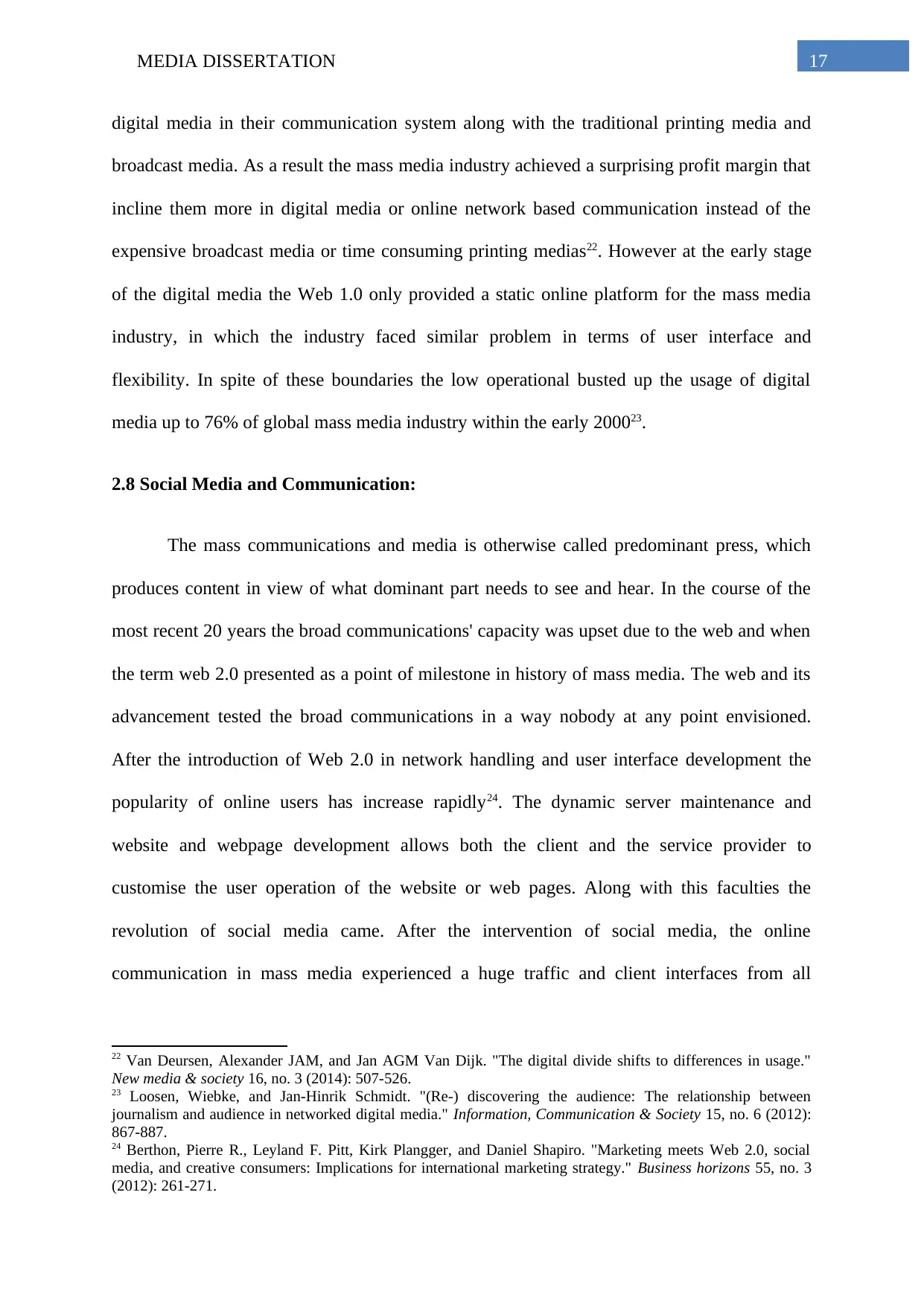
MEDIA DISSERTATION 17
digital media in their communication system along with the traditional printing media and
broadcast media. As a result the mass media industry achieved a surprising profit margin that
incline them more in digital media or online network based communication instead of the
expensive broadcast media or time consuming printing medias22. However at the early stage
of the digital media the Web 1.0 only provided a static online platform for the mass media
industry, in which the industry faced similar problem in terms of user interface and
flexibility. In spite of these boundaries the low operational busted up the usage of digital
media up to 76% of global mass media industry within the early 200023.
2.8 Social Media and Communication:
The mass communications and media is otherwise called predominant press, which
produces content in view of what dominant part needs to see and hear. In the course of the
most recent 20 years the broad communications' capacity was upset due to the web and when
the term web 2.0 presented as a point of milestone in history of mass media. The web and its
advancement tested the broad communications in a way nobody at any point envisioned.
After the introduction of Web 2.0 in network handling and user interface development the
popularity of online users has increase rapidly24. The dynamic server maintenance and
website and webpage development allows both the client and the service provider to
customise the user operation of the website or web pages. Along with this faculties the
revolution of social media came. After the intervention of social media, the online
communication in mass media experienced a huge traffic and client interfaces from all
22 Van Deursen, Alexander JAM, and Jan AGM Van Dijk. "The digital divide shifts to differences in usage."
New media & society 16, no. 3 (2014): 507-526.
23 Loosen, Wiebke, and Jan-Hinrik Schmidt. "(Re-) discovering the audience: The relationship between
journalism and audience in networked digital media." Information, Communication & Society 15, no. 6 (2012):
867-887.
24 Berthon, Pierre R., Leyland F. Pitt, Kirk Plangger, and Daniel Shapiro. "Marketing meets Web 2.0, social
media, and creative consumers: Implications for international marketing strategy." Business horizons 55, no. 3
(2012): 261-271.
digital media in their communication system along with the traditional printing media and
broadcast media. As a result the mass media industry achieved a surprising profit margin that
incline them more in digital media or online network based communication instead of the
expensive broadcast media or time consuming printing medias22. However at the early stage
of the digital media the Web 1.0 only provided a static online platform for the mass media
industry, in which the industry faced similar problem in terms of user interface and
flexibility. In spite of these boundaries the low operational busted up the usage of digital
media up to 76% of global mass media industry within the early 200023.
2.8 Social Media and Communication:
The mass communications and media is otherwise called predominant press, which
produces content in view of what dominant part needs to see and hear. In the course of the
most recent 20 years the broad communications' capacity was upset due to the web and when
the term web 2.0 presented as a point of milestone in history of mass media. The web and its
advancement tested the broad communications in a way nobody at any point envisioned.
After the introduction of Web 2.0 in network handling and user interface development the
popularity of online users has increase rapidly24. The dynamic server maintenance and
website and webpage development allows both the client and the service provider to
customise the user operation of the website or web pages. Along with this faculties the
revolution of social media came. After the intervention of social media, the online
communication in mass media experienced a huge traffic and client interfaces from all
22 Van Deursen, Alexander JAM, and Jan AGM Van Dijk. "The digital divide shifts to differences in usage."
New media & society 16, no. 3 (2014): 507-526.
23 Loosen, Wiebke, and Jan-Hinrik Schmidt. "(Re-) discovering the audience: The relationship between
journalism and audience in networked digital media." Information, Communication & Society 15, no. 6 (2012):
867-887.
24 Berthon, Pierre R., Leyland F. Pitt, Kirk Plangger, and Daniel Shapiro. "Marketing meets Web 2.0, social
media, and creative consumers: Implications for international marketing strategy." Business horizons 55, no. 3
(2012): 261-271.
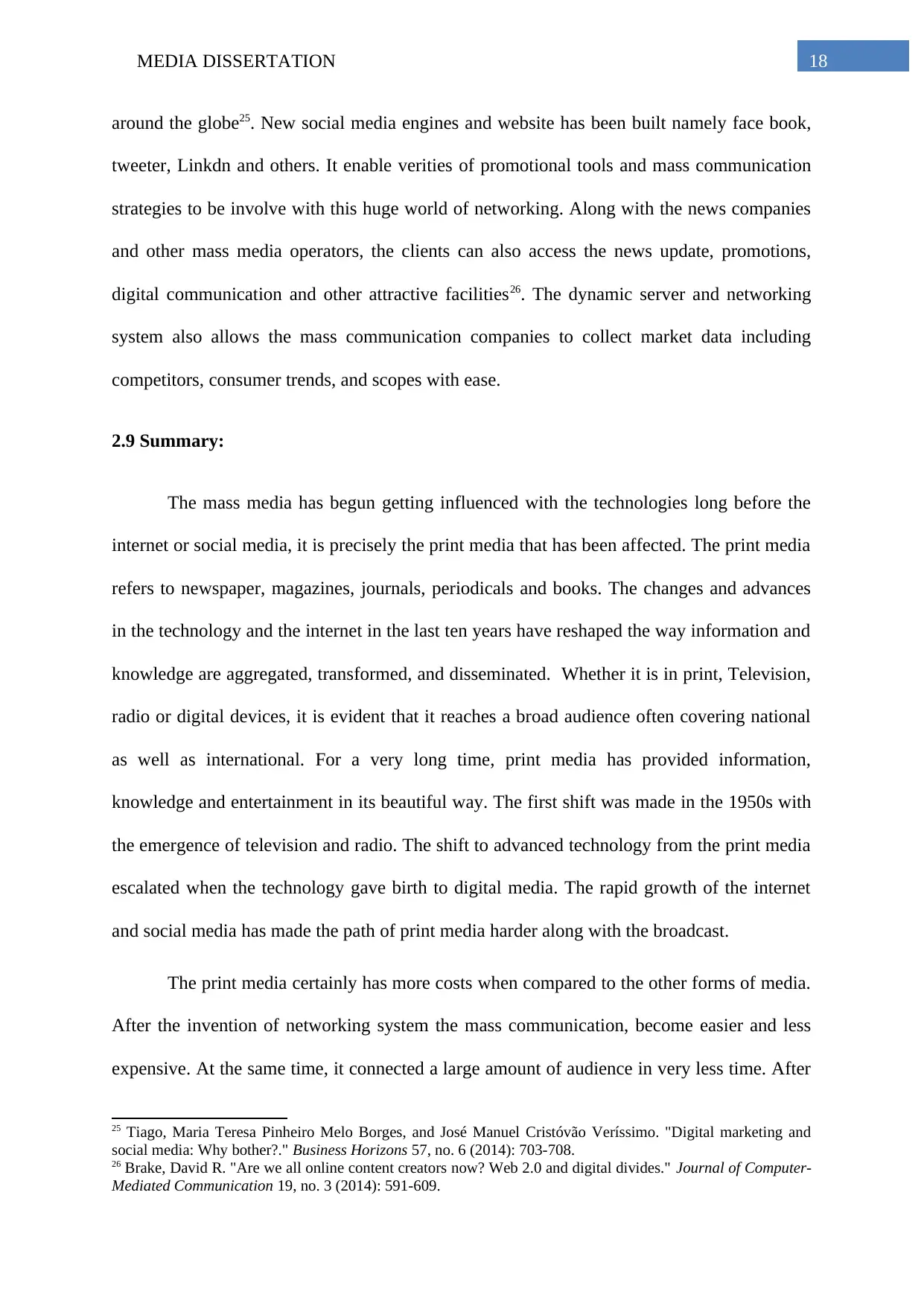
MEDIA DISSERTATION 18
around the globe25. New social media engines and website has been built namely face book,
tweeter, Linkdn and others. It enable verities of promotional tools and mass communication
strategies to be involve with this huge world of networking. Along with the news companies
and other mass media operators, the clients can also access the news update, promotions,
digital communication and other attractive facilities26. The dynamic server and networking
system also allows the mass communication companies to collect market data including
competitors, consumer trends, and scopes with ease.
2.9 Summary:
The mass media has begun getting influenced with the technologies long before the
internet or social media, it is precisely the print media that has been affected. The print media
refers to newspaper, magazines, journals, periodicals and books. The changes and advances
in the technology and the internet in the last ten years have reshaped the way information and
knowledge are aggregated, transformed, and disseminated. Whether it is in print, Television,
radio or digital devices, it is evident that it reaches a broad audience often covering national
as well as international. For a very long time, print media has provided information,
knowledge and entertainment in its beautiful way. The first shift was made in the 1950s with
the emergence of television and radio. The shift to advanced technology from the print media
escalated when the technology gave birth to digital media. The rapid growth of the internet
and social media has made the path of print media harder along with the broadcast.
The print media certainly has more costs when compared to the other forms of media.
After the invention of networking system the mass communication, become easier and less
expensive. At the same time, it connected a large amount of audience in very less time. After
25 Tiago, Maria Teresa Pinheiro Melo Borges, and José Manuel Cristóvão Veríssimo. "Digital marketing and
social media: Why bother?." Business Horizons 57, no. 6 (2014): 703-708.
26 Brake, David R. "Are we all online content creators now? Web 2.0 and digital divides." Journal of Computer-
Mediated Communication 19, no. 3 (2014): 591-609.
around the globe25. New social media engines and website has been built namely face book,
tweeter, Linkdn and others. It enable verities of promotional tools and mass communication
strategies to be involve with this huge world of networking. Along with the news companies
and other mass media operators, the clients can also access the news update, promotions,
digital communication and other attractive facilities26. The dynamic server and networking
system also allows the mass communication companies to collect market data including
competitors, consumer trends, and scopes with ease.
2.9 Summary:
The mass media has begun getting influenced with the technologies long before the
internet or social media, it is precisely the print media that has been affected. The print media
refers to newspaper, magazines, journals, periodicals and books. The changes and advances
in the technology and the internet in the last ten years have reshaped the way information and
knowledge are aggregated, transformed, and disseminated. Whether it is in print, Television,
radio or digital devices, it is evident that it reaches a broad audience often covering national
as well as international. For a very long time, print media has provided information,
knowledge and entertainment in its beautiful way. The first shift was made in the 1950s with
the emergence of television and radio. The shift to advanced technology from the print media
escalated when the technology gave birth to digital media. The rapid growth of the internet
and social media has made the path of print media harder along with the broadcast.
The print media certainly has more costs when compared to the other forms of media.
After the invention of networking system the mass communication, become easier and less
expensive. At the same time, it connected a large amount of audience in very less time. After
25 Tiago, Maria Teresa Pinheiro Melo Borges, and José Manuel Cristóvão Veríssimo. "Digital marketing and
social media: Why bother?." Business Horizons 57, no. 6 (2014): 703-708.
26 Brake, David R. "Are we all online content creators now? Web 2.0 and digital divides." Journal of Computer-
Mediated Communication 19, no. 3 (2014): 591-609.
Paraphrase This Document
Need a fresh take? Get an instant paraphrase of this document with our AI Paraphraser

MEDIA DISSERTATION 19
the introduction of Web 2.0 in network handling and user interface development the
popularity of online users has increase rapidly. The dynamic server maintenance and website
and webpage development allows both the client and the service provider to customise the
user operation of the website or web pages. Moreover in last 20 years the mass
communications' and media increased due to the web and web 2.0, that presented a point of
milestone in history of mass media. The rapid growth of the internet and social media has
made the path of print media harder along with the broadcast.
2.10 Literature gap:
This literature review mostly focused on the precious published report and theoretical
analysis. The literatures that were selected for review did not provide any real time data in
terms of interview and survey. Therefore the literature review is based on the reanalysis and
presentation of research reports and books that also followed the secondary data collection
method. Therefore, in this literature review the lack of survey and interview based data
analysis was clear. Apart from that the literature review has been focused only the benefit of
digital media over print media, instead of discussing the further possible consequences due
to the ultimate collapse of print media.
the introduction of Web 2.0 in network handling and user interface development the
popularity of online users has increase rapidly. The dynamic server maintenance and website
and webpage development allows both the client and the service provider to customise the
user operation of the website or web pages. Moreover in last 20 years the mass
communications' and media increased due to the web and web 2.0, that presented a point of
milestone in history of mass media. The rapid growth of the internet and social media has
made the path of print media harder along with the broadcast.
2.10 Literature gap:
This literature review mostly focused on the precious published report and theoretical
analysis. The literatures that were selected for review did not provide any real time data in
terms of interview and survey. Therefore the literature review is based on the reanalysis and
presentation of research reports and books that also followed the secondary data collection
method. Therefore, in this literature review the lack of survey and interview based data
analysis was clear. Apart from that the literature review has been focused only the benefit of
digital media over print media, instead of discussing the further possible consequences due
to the ultimate collapse of print media.

MEDIA DISSERTATION 20
Chapter 3: Research methodology
3.1 Method outline
The term method outline emphasise the structure of the research that holds the
foundation of any research from the beginning to end. The research outline usually comprises
the major components of the research paper including method of the research, research
strategy, data collection and analysis strategy, research onion and chosen tools for the
research27. For this research the research philosophy, design and approach relied on the
outline of the methodology. At the beginning of this research based on the changes of mass
media due to technological advancement and declination of print media, the required data,
procedure and strategy, has been formulated. It helped to develop the method outline for this
research accordingly.
3.2 Research onion
The research onion is the graphical representation of the research procedure through
the layer based design. The research onion consists of multiple research starting from its core
to exterior surface. The outer layer defines the initial stage of the research method including
the research philosophy. Along with the depth of the layers the proration of methodology
depends. Therefore, at the core of the onion the data analysis is situated. In this research the
onion represents the philosophy, design, approach, data collection strategy and data analysis
of this research sequentially from the external surface to the core of the onion.
27 Neuman, W. Lawrence. Social research methods: Qualitative and quantitative approaches. Pearson
education, 2013.
Chapter 3: Research methodology
3.1 Method outline
The term method outline emphasise the structure of the research that holds the
foundation of any research from the beginning to end. The research outline usually comprises
the major components of the research paper including method of the research, research
strategy, data collection and analysis strategy, research onion and chosen tools for the
research27. For this research the research philosophy, design and approach relied on the
outline of the methodology. At the beginning of this research based on the changes of mass
media due to technological advancement and declination of print media, the required data,
procedure and strategy, has been formulated. It helped to develop the method outline for this
research accordingly.
3.2 Research onion
The research onion is the graphical representation of the research procedure through
the layer based design. The research onion consists of multiple research starting from its core
to exterior surface. The outer layer defines the initial stage of the research method including
the research philosophy. Along with the depth of the layers the proration of methodology
depends. Therefore, at the core of the onion the data analysis is situated. In this research the
onion represents the philosophy, design, approach, data collection strategy and data analysis
of this research sequentially from the external surface to the core of the onion.
27 Neuman, W. Lawrence. Social research methods: Qualitative and quantitative approaches. Pearson
education, 2013.
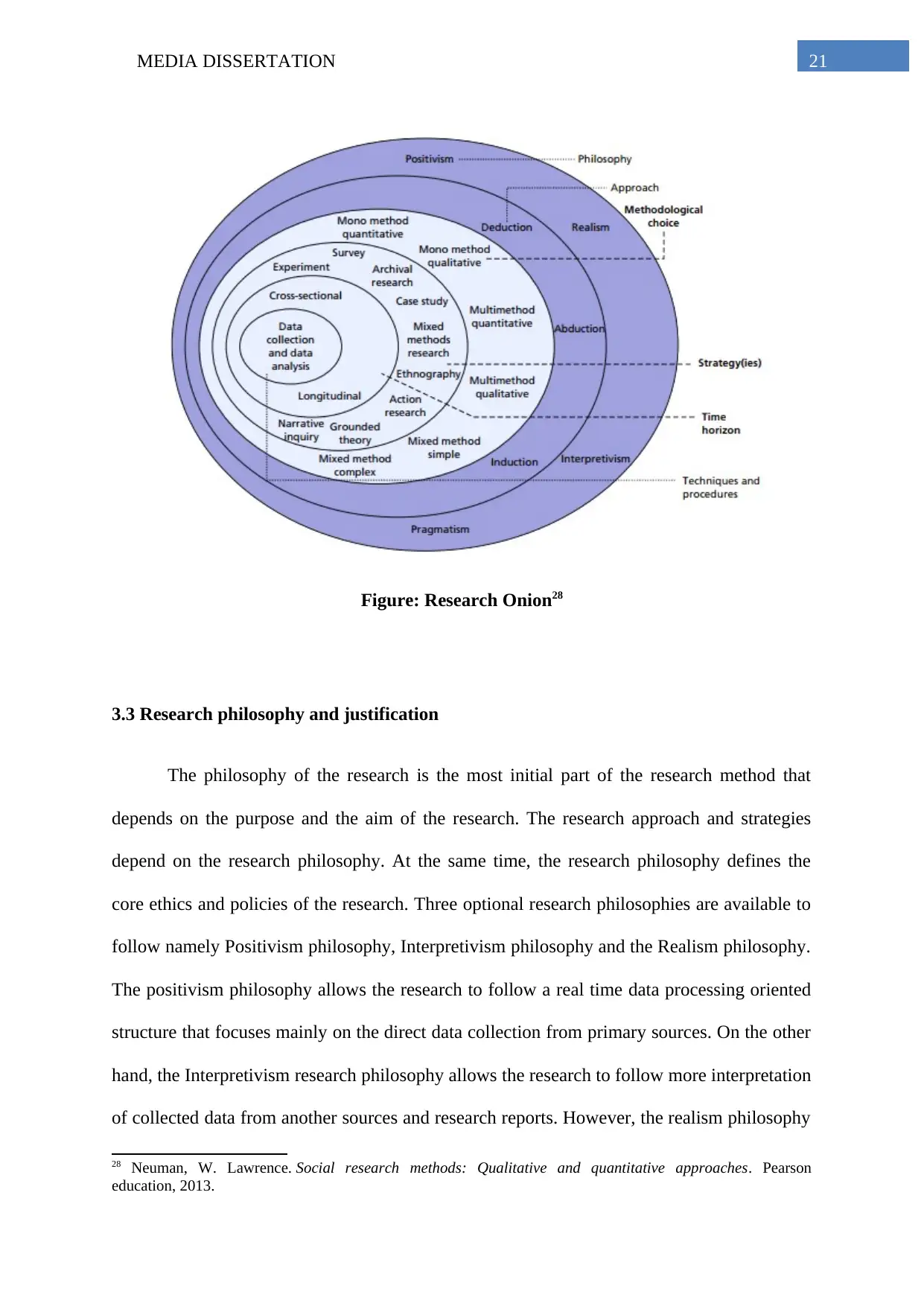
MEDIA DISSERTATION 21
Figure: Research Onion28
3.3 Research philosophy and justification
The philosophy of the research is the most initial part of the research method that
depends on the purpose and the aim of the research. The research approach and strategies
depend on the research philosophy. At the same time, the research philosophy defines the
core ethics and policies of the research. Three optional research philosophies are available to
follow namely Positivism philosophy, Interpretivism philosophy and the Realism philosophy.
The positivism philosophy allows the research to follow a real time data processing oriented
structure that focuses mainly on the direct data collection from primary sources. On the other
hand, the Interpretivism research philosophy allows the research to follow more interpretation
of collected data from another sources and research reports. However, the realism philosophy
28 Neuman, W. Lawrence. Social research methods: Qualitative and quantitative approaches. Pearson
education, 2013.
Figure: Research Onion28
3.3 Research philosophy and justification
The philosophy of the research is the most initial part of the research method that
depends on the purpose and the aim of the research. The research approach and strategies
depend on the research philosophy. At the same time, the research philosophy defines the
core ethics and policies of the research. Three optional research philosophies are available to
follow namely Positivism philosophy, Interpretivism philosophy and the Realism philosophy.
The positivism philosophy allows the research to follow a real time data processing oriented
structure that focuses mainly on the direct data collection from primary sources. On the other
hand, the Interpretivism research philosophy allows the research to follow more interpretation
of collected data from another sources and research reports. However, the realism philosophy
28 Neuman, W. Lawrence. Social research methods: Qualitative and quantitative approaches. Pearson
education, 2013.
Secure Best Marks with AI Grader
Need help grading? Try our AI Grader for instant feedback on your assignments.
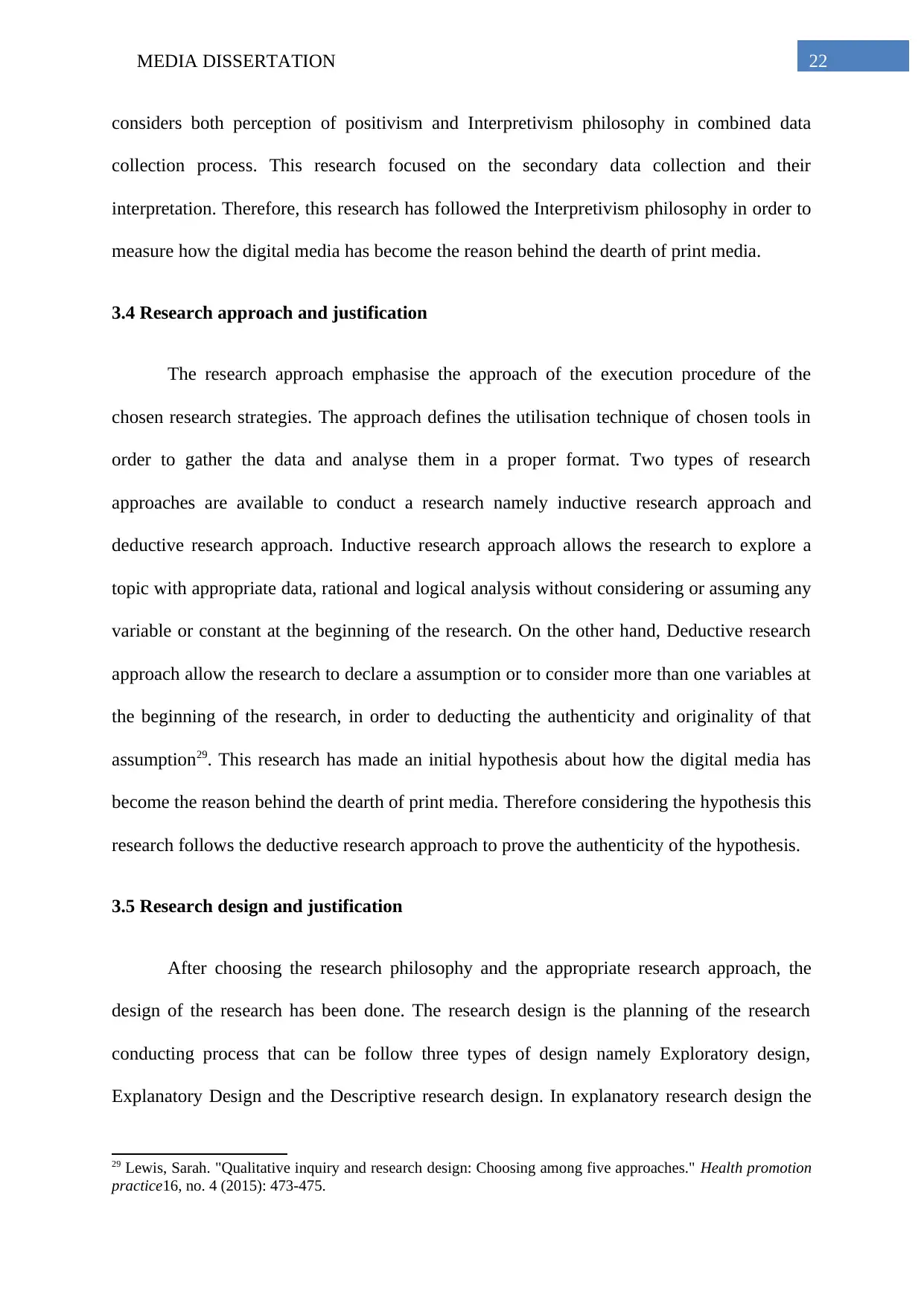
MEDIA DISSERTATION 22
considers both perception of positivism and Interpretivism philosophy in combined data
collection process. This research focused on the secondary data collection and their
interpretation. Therefore, this research has followed the Interpretivism philosophy in order to
measure how the digital media has become the reason behind the dearth of print media.
3.4 Research approach and justification
The research approach emphasise the approach of the execution procedure of the
chosen research strategies. The approach defines the utilisation technique of chosen tools in
order to gather the data and analyse them in a proper format. Two types of research
approaches are available to conduct a research namely inductive research approach and
deductive research approach. Inductive research approach allows the research to explore a
topic with appropriate data, rational and logical analysis without considering or assuming any
variable or constant at the beginning of the research. On the other hand, Deductive research
approach allow the research to declare a assumption or to consider more than one variables at
the beginning of the research, in order to deducting the authenticity and originality of that
assumption29. This research has made an initial hypothesis about how the digital media has
become the reason behind the dearth of print media. Therefore considering the hypothesis this
research follows the deductive research approach to prove the authenticity of the hypothesis.
3.5 Research design and justification
After choosing the research philosophy and the appropriate research approach, the
design of the research has been done. The research design is the planning of the research
conducting process that can be follow three types of design namely Exploratory design,
Explanatory Design and the Descriptive research design. In explanatory research design the
29 Lewis, Sarah. "Qualitative inquiry and research design: Choosing among five approaches." Health promotion
practice16, no. 4 (2015): 473-475.
considers both perception of positivism and Interpretivism philosophy in combined data
collection process. This research focused on the secondary data collection and their
interpretation. Therefore, this research has followed the Interpretivism philosophy in order to
measure how the digital media has become the reason behind the dearth of print media.
3.4 Research approach and justification
The research approach emphasise the approach of the execution procedure of the
chosen research strategies. The approach defines the utilisation technique of chosen tools in
order to gather the data and analyse them in a proper format. Two types of research
approaches are available to conduct a research namely inductive research approach and
deductive research approach. Inductive research approach allows the research to explore a
topic with appropriate data, rational and logical analysis without considering or assuming any
variable or constant at the beginning of the research. On the other hand, Deductive research
approach allow the research to declare a assumption or to consider more than one variables at
the beginning of the research, in order to deducting the authenticity and originality of that
assumption29. This research has made an initial hypothesis about how the digital media has
become the reason behind the dearth of print media. Therefore considering the hypothesis this
research follows the deductive research approach to prove the authenticity of the hypothesis.
3.5 Research design and justification
After choosing the research philosophy and the appropriate research approach, the
design of the research has been done. The research design is the planning of the research
conducting process that can be follow three types of design namely Exploratory design,
Explanatory Design and the Descriptive research design. In explanatory research design the
29 Lewis, Sarah. "Qualitative inquiry and research design: Choosing among five approaches." Health promotion
practice16, no. 4 (2015): 473-475.

MEDIA DISSERTATION 23
aim of the research method is to testify a hypothesis or assumption which is declared at the
beginning of the research through cause effect analysis. The exploratory research design
allows to explore in a topic or a particular situation with enough evidences and rational
analysis in a open ended environment. Descriptive research design describe a particular
condition which does not have any particular goal to meet. This research has made an initial
hypothesis about how the digital media has become the reason behind the dearth of print
media. Therefore considering the hypothesis this research follows the Explanatory research
approach to prove the authenticity of the hypothesis.
3.6 Research strategy and justification
The research strategy refers the strategic selection of the tools through which the
research can collect the data and analyse them aiming to the possible deliverables of the
research. This research has made an initial hypothesis about how the digital media has
become the reason behind the dearth of print media. Therefore considering the hypothesis this
research follows the secondary data collection from article, published report, conducted
researches along with 2 case studies. The research utilises the qualitative analysis process
with the strategic implementation of case study analysis. The case studies are selected
focusing on the mass media companies in Singapore, who faced considerable amount of
changes because of the intervention of digital media.
3.7 Data collection method
Data collection can be done by following two types of data collection method namely
Primary data collection and Secondary data collection. The primary data collection method
refers the collection of data from real time environment by utilising various data collection
tools including survey, interviews and others. On the other hand, the secondary data
collection method focus on secondary sources including previously published report, research
aim of the research method is to testify a hypothesis or assumption which is declared at the
beginning of the research through cause effect analysis. The exploratory research design
allows to explore in a topic or a particular situation with enough evidences and rational
analysis in a open ended environment. Descriptive research design describe a particular
condition which does not have any particular goal to meet. This research has made an initial
hypothesis about how the digital media has become the reason behind the dearth of print
media. Therefore considering the hypothesis this research follows the Explanatory research
approach to prove the authenticity of the hypothesis.
3.6 Research strategy and justification
The research strategy refers the strategic selection of the tools through which the
research can collect the data and analyse them aiming to the possible deliverables of the
research. This research has made an initial hypothesis about how the digital media has
become the reason behind the dearth of print media. Therefore considering the hypothesis this
research follows the secondary data collection from article, published report, conducted
researches along with 2 case studies. The research utilises the qualitative analysis process
with the strategic implementation of case study analysis. The case studies are selected
focusing on the mass media companies in Singapore, who faced considerable amount of
changes because of the intervention of digital media.
3.7 Data collection method
Data collection can be done by following two types of data collection method namely
Primary data collection and Secondary data collection. The primary data collection method
refers the collection of data from real time environment by utilising various data collection
tools including survey, interviews and others. On the other hand, the secondary data
collection method focus on secondary sources including previously published report, research

MEDIA DISSERTATION 24
articles, organisational broadcast and other online and offline sources 30. This research is
completely based on the secondary data collection from various secondary resources
including the case studies, published report, articles and other mass media oriented resources.
At the same time, the case studies are selected from secondary resource for analysis. This
research has made an initial hypothesis about how the digital media has become the reason
behind the dearth of print media. Therefore considering the hypothesis this research follows
the secondary data collection approach to prove the authenticity of the hypothesis. The
secondary data collection has been made by focusing on the mass media companies in
Singapore, who faced considerable amount of changes because of the intervention of digital
media.
3.8 Sample size
Sample size refers the range of the platform on which the date will be collected
considering either secondary or primary data collection procedure. For this research, the
resource of the data collection is secondary. For secondary data collection the sample size is
divided in to two section namely literature review and case study based analysis. For case
study based analysis, this research has been analysed 2 case study of 2 mass media companies
in Singapore. For literature review the research paper has been focused on the history of
global mass communication and media industry and the relevant literature, published report,
business report, research articles and others.
3.9 Data analysis method
The data analysis procedure is the most essential part of the research that holds the
achievement of the research. In data analysis, the collected data has been analysed through
various techniques considering several parameters. Two types of Data analysis method can be
30 Flick, Uwe. Introducing research methodology: A beginner's guide to doing a research project. Sage, 2015.
articles, organisational broadcast and other online and offline sources 30. This research is
completely based on the secondary data collection from various secondary resources
including the case studies, published report, articles and other mass media oriented resources.
At the same time, the case studies are selected from secondary resource for analysis. This
research has made an initial hypothesis about how the digital media has become the reason
behind the dearth of print media. Therefore considering the hypothesis this research follows
the secondary data collection approach to prove the authenticity of the hypothesis. The
secondary data collection has been made by focusing on the mass media companies in
Singapore, who faced considerable amount of changes because of the intervention of digital
media.
3.8 Sample size
Sample size refers the range of the platform on which the date will be collected
considering either secondary or primary data collection procedure. For this research, the
resource of the data collection is secondary. For secondary data collection the sample size is
divided in to two section namely literature review and case study based analysis. For case
study based analysis, this research has been analysed 2 case study of 2 mass media companies
in Singapore. For literature review the research paper has been focused on the history of
global mass communication and media industry and the relevant literature, published report,
business report, research articles and others.
3.9 Data analysis method
The data analysis procedure is the most essential part of the research that holds the
achievement of the research. In data analysis, the collected data has been analysed through
various techniques considering several parameters. Two types of Data analysis method can be
30 Flick, Uwe. Introducing research methodology: A beginner's guide to doing a research project. Sage, 2015.
Paraphrase This Document
Need a fresh take? Get an instant paraphrase of this document with our AI Paraphraser
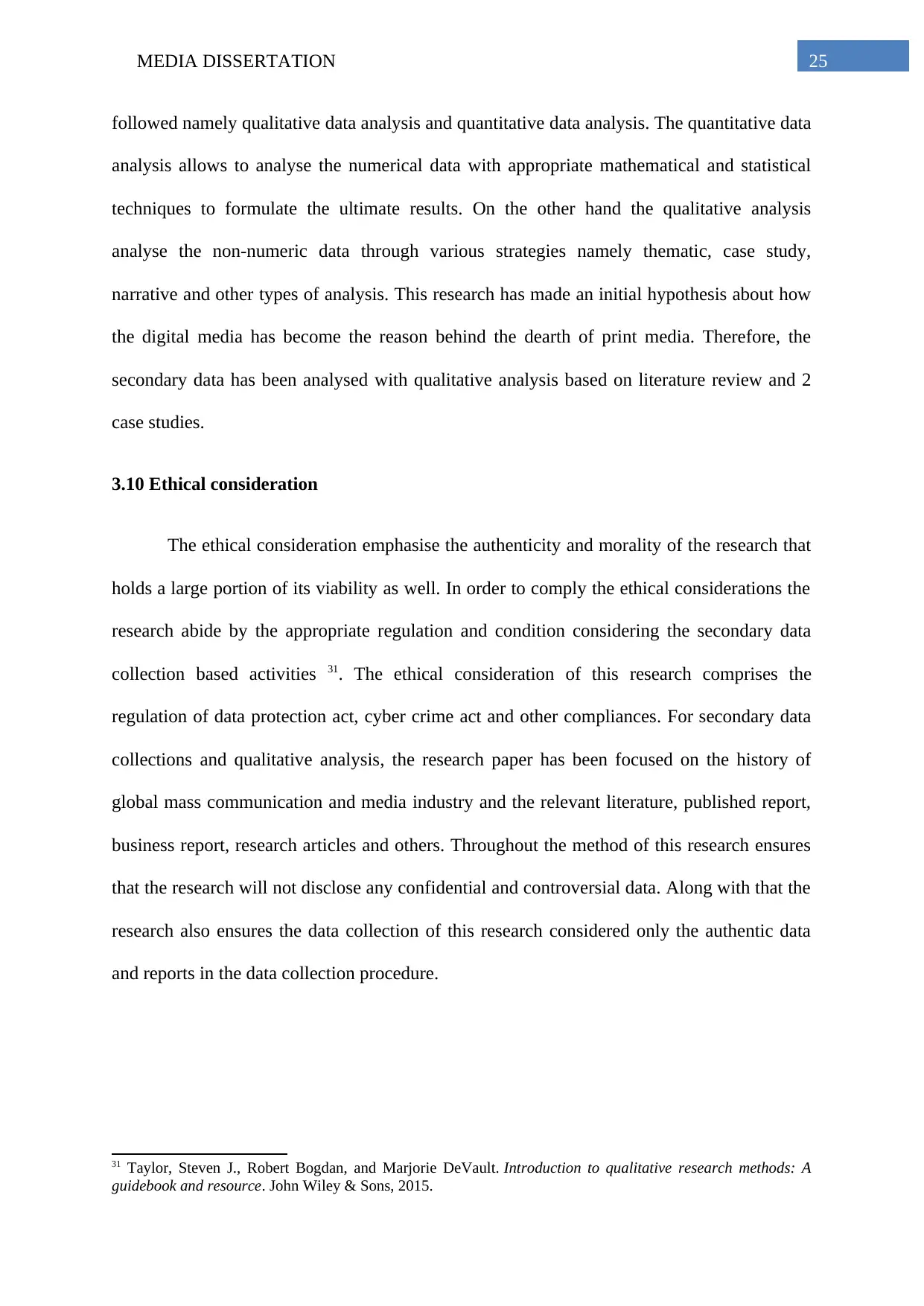
MEDIA DISSERTATION 25
followed namely qualitative data analysis and quantitative data analysis. The quantitative data
analysis allows to analyse the numerical data with appropriate mathematical and statistical
techniques to formulate the ultimate results. On the other hand the qualitative analysis
analyse the non-numeric data through various strategies namely thematic, case study,
narrative and other types of analysis. This research has made an initial hypothesis about how
the digital media has become the reason behind the dearth of print media. Therefore, the
secondary data has been analysed with qualitative analysis based on literature review and 2
case studies.
3.10 Ethical consideration
The ethical consideration emphasise the authenticity and morality of the research that
holds a large portion of its viability as well. In order to comply the ethical considerations the
research abide by the appropriate regulation and condition considering the secondary data
collection based activities 31. The ethical consideration of this research comprises the
regulation of data protection act, cyber crime act and other compliances. For secondary data
collections and qualitative analysis, the research paper has been focused on the history of
global mass communication and media industry and the relevant literature, published report,
business report, research articles and others. Throughout the method of this research ensures
that the research will not disclose any confidential and controversial data. Along with that the
research also ensures the data collection of this research considered only the authentic data
and reports in the data collection procedure.
31 Taylor, Steven J., Robert Bogdan, and Marjorie DeVault. Introduction to qualitative research methods: A
guidebook and resource. John Wiley & Sons, 2015.
followed namely qualitative data analysis and quantitative data analysis. The quantitative data
analysis allows to analyse the numerical data with appropriate mathematical and statistical
techniques to formulate the ultimate results. On the other hand the qualitative analysis
analyse the non-numeric data through various strategies namely thematic, case study,
narrative and other types of analysis. This research has made an initial hypothesis about how
the digital media has become the reason behind the dearth of print media. Therefore, the
secondary data has been analysed with qualitative analysis based on literature review and 2
case studies.
3.10 Ethical consideration
The ethical consideration emphasise the authenticity and morality of the research that
holds a large portion of its viability as well. In order to comply the ethical considerations the
research abide by the appropriate regulation and condition considering the secondary data
collection based activities 31. The ethical consideration of this research comprises the
regulation of data protection act, cyber crime act and other compliances. For secondary data
collections and qualitative analysis, the research paper has been focused on the history of
global mass communication and media industry and the relevant literature, published report,
business report, research articles and others. Throughout the method of this research ensures
that the research will not disclose any confidential and controversial data. Along with that the
research also ensures the data collection of this research considered only the authentic data
and reports in the data collection procedure.
31 Taylor, Steven J., Robert Bogdan, and Marjorie DeVault. Introduction to qualitative research methods: A
guidebook and resource. John Wiley & Sons, 2015.
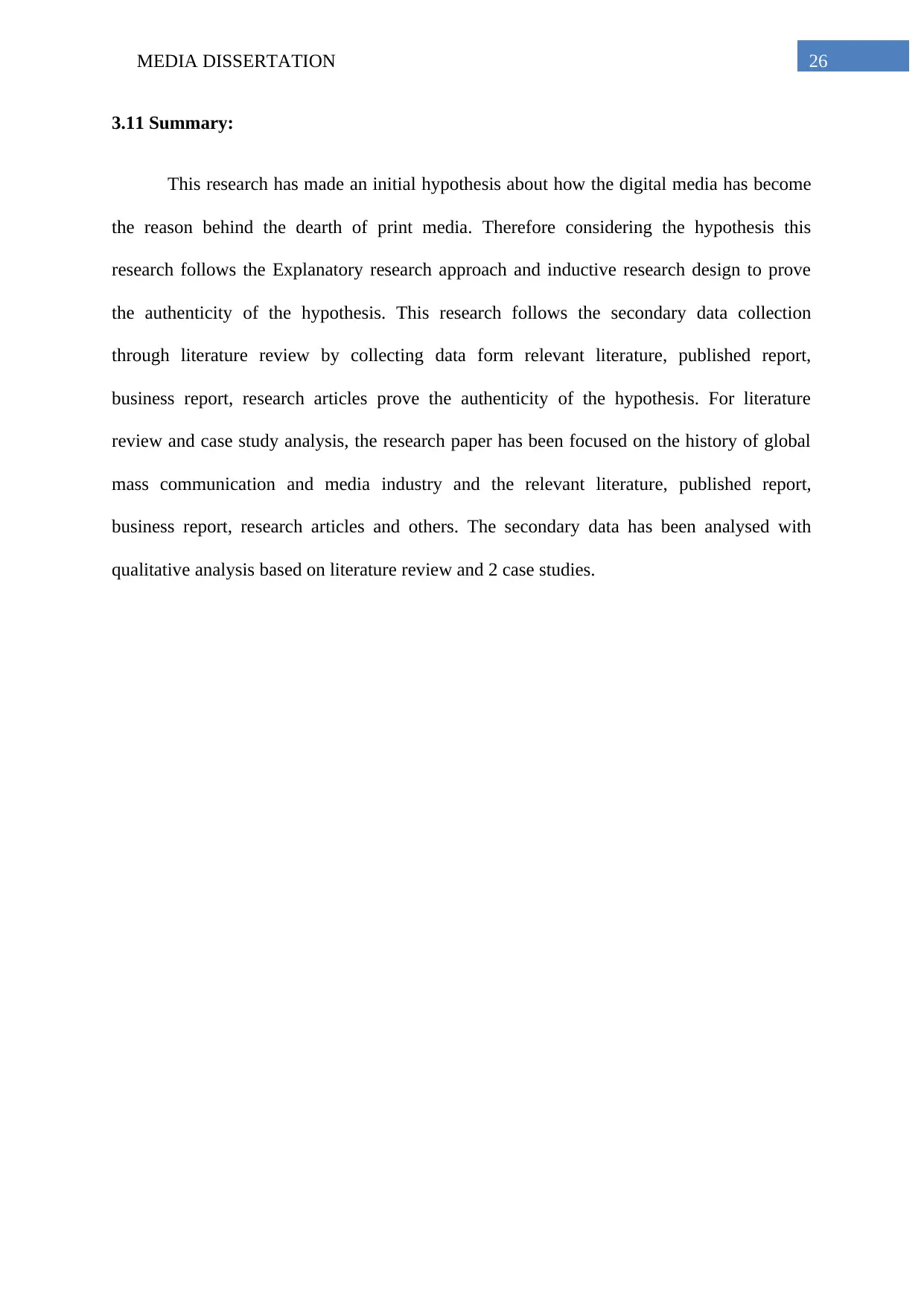
MEDIA DISSERTATION 26
3.11 Summary:
This research has made an initial hypothesis about how the digital media has become
the reason behind the dearth of print media. Therefore considering the hypothesis this
research follows the Explanatory research approach and inductive research design to prove
the authenticity of the hypothesis. This research follows the secondary data collection
through literature review by collecting data form relevant literature, published report,
business report, research articles prove the authenticity of the hypothesis. For literature
review and case study analysis, the research paper has been focused on the history of global
mass communication and media industry and the relevant literature, published report,
business report, research articles and others. The secondary data has been analysed with
qualitative analysis based on literature review and 2 case studies.
3.11 Summary:
This research has made an initial hypothesis about how the digital media has become
the reason behind the dearth of print media. Therefore considering the hypothesis this
research follows the Explanatory research approach and inductive research design to prove
the authenticity of the hypothesis. This research follows the secondary data collection
through literature review by collecting data form relevant literature, published report,
business report, research articles prove the authenticity of the hypothesis. For literature
review and case study analysis, the research paper has been focused on the history of global
mass communication and media industry and the relevant literature, published report,
business report, research articles and others. The secondary data has been analysed with
qualitative analysis based on literature review and 2 case studies.
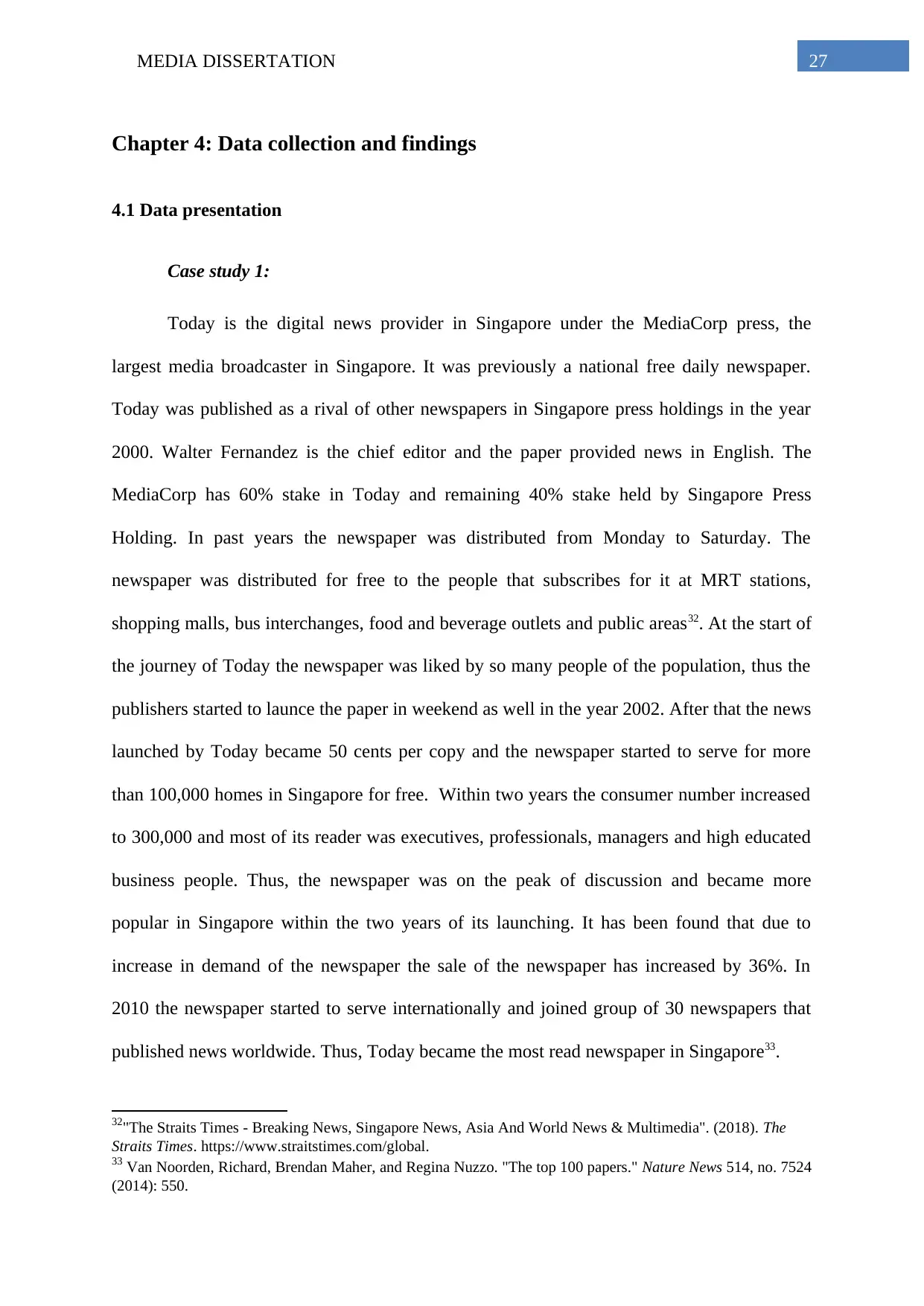
MEDIA DISSERTATION 27
Chapter 4: Data collection and findings
4.1 Data presentation
Case study 1:
Today is the digital news provider in Singapore under the MediaCorp press, the
largest media broadcaster in Singapore. It was previously a national free daily newspaper.
Today was published as a rival of other newspapers in Singapore press holdings in the year
2000. Walter Fernandez is the chief editor and the paper provided news in English. The
MediaCorp has 60% stake in Today and remaining 40% stake held by Singapore Press
Holding. In past years the newspaper was distributed from Monday to Saturday. The
newspaper was distributed for free to the people that subscribes for it at MRT stations,
shopping malls, bus interchanges, food and beverage outlets and public areas32. At the start of
the journey of Today the newspaper was liked by so many people of the population, thus the
publishers started to launce the paper in weekend as well in the year 2002. After that the news
launched by Today became 50 cents per copy and the newspaper started to serve for more
than 100,000 homes in Singapore for free. Within two years the consumer number increased
to 300,000 and most of its reader was executives, professionals, managers and high educated
business people. Thus, the newspaper was on the peak of discussion and became more
popular in Singapore within the two years of its launching. It has been found that due to
increase in demand of the newspaper the sale of the newspaper has increased by 36%. In
2010 the newspaper started to serve internationally and joined group of 30 newspapers that
published news worldwide. Thus, Today became the most read newspaper in Singapore33.
32"The Straits Times - Breaking News, Singapore News, Asia And World News & Multimedia". (2018). The
Straits Times. https://www.straitstimes.com/global.
33 Van Noorden, Richard, Brendan Maher, and Regina Nuzzo. "The top 100 papers." Nature News 514, no. 7524
(2014): 550.
Chapter 4: Data collection and findings
4.1 Data presentation
Case study 1:
Today is the digital news provider in Singapore under the MediaCorp press, the
largest media broadcaster in Singapore. It was previously a national free daily newspaper.
Today was published as a rival of other newspapers in Singapore press holdings in the year
2000. Walter Fernandez is the chief editor and the paper provided news in English. The
MediaCorp has 60% stake in Today and remaining 40% stake held by Singapore Press
Holding. In past years the newspaper was distributed from Monday to Saturday. The
newspaper was distributed for free to the people that subscribes for it at MRT stations,
shopping malls, bus interchanges, food and beverage outlets and public areas32. At the start of
the journey of Today the newspaper was liked by so many people of the population, thus the
publishers started to launce the paper in weekend as well in the year 2002. After that the news
launched by Today became 50 cents per copy and the newspaper started to serve for more
than 100,000 homes in Singapore for free. Within two years the consumer number increased
to 300,000 and most of its reader was executives, professionals, managers and high educated
business people. Thus, the newspaper was on the peak of discussion and became more
popular in Singapore within the two years of its launching. It has been found that due to
increase in demand of the newspaper the sale of the newspaper has increased by 36%. In
2010 the newspaper started to serve internationally and joined group of 30 newspapers that
published news worldwide. Thus, Today became the most read newspaper in Singapore33.
32"The Straits Times - Breaking News, Singapore News, Asia And World News & Multimedia". (2018). The
Straits Times. https://www.straitstimes.com/global.
33 Van Noorden, Richard, Brendan Maher, and Regina Nuzzo. "The top 100 papers." Nature News 514, no. 7524
(2014): 550.
Secure Best Marks with AI Grader
Need help grading? Try our AI Grader for instant feedback on your assignments.
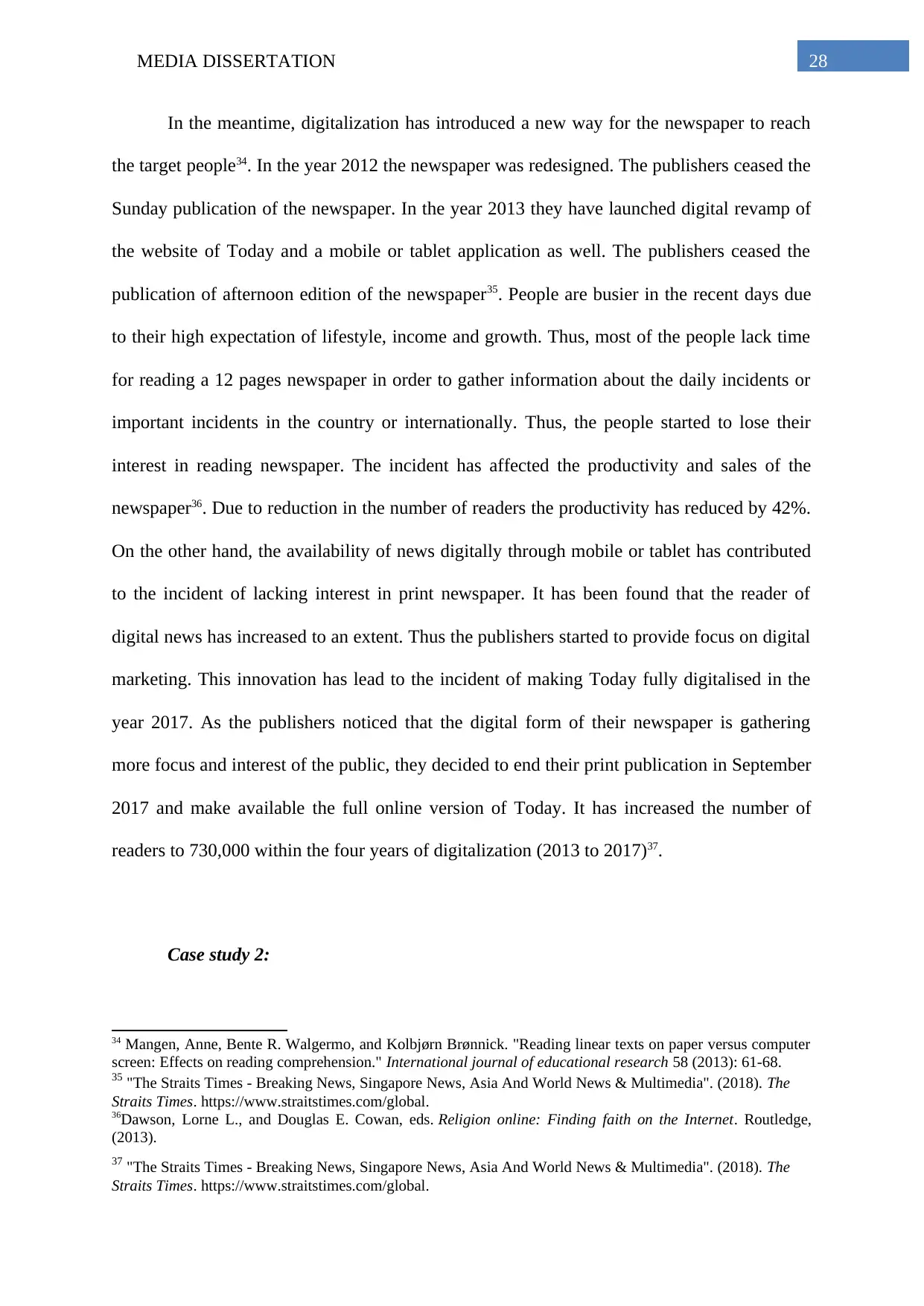
MEDIA DISSERTATION 28
In the meantime, digitalization has introduced a new way for the newspaper to reach
the target people34. In the year 2012 the newspaper was redesigned. The publishers ceased the
Sunday publication of the newspaper. In the year 2013 they have launched digital revamp of
the website of Today and a mobile or tablet application as well. The publishers ceased the
publication of afternoon edition of the newspaper35. People are busier in the recent days due
to their high expectation of lifestyle, income and growth. Thus, most of the people lack time
for reading a 12 pages newspaper in order to gather information about the daily incidents or
important incidents in the country or internationally. Thus, the people started to lose their
interest in reading newspaper. The incident has affected the productivity and sales of the
newspaper36. Due to reduction in the number of readers the productivity has reduced by 42%.
On the other hand, the availability of news digitally through mobile or tablet has contributed
to the incident of lacking interest in print newspaper. It has been found that the reader of
digital news has increased to an extent. Thus the publishers started to provide focus on digital
marketing. This innovation has lead to the incident of making Today fully digitalised in the
year 2017. As the publishers noticed that the digital form of their newspaper is gathering
more focus and interest of the public, they decided to end their print publication in September
2017 and make available the full online version of Today. It has increased the number of
readers to 730,000 within the four years of digitalization (2013 to 2017)37.
Case study 2:
34 Mangen, Anne, Bente R. Walgermo, and Kolbjørn Brønnick. "Reading linear texts on paper versus computer
screen: Effects on reading comprehension." International journal of educational research 58 (2013): 61-68.
35 "The Straits Times - Breaking News, Singapore News, Asia And World News & Multimedia". (2018). The
Straits Times. https://www.straitstimes.com/global.
36Dawson, Lorne L., and Douglas E. Cowan, eds. Religion online: Finding faith on the Internet. Routledge,
(2013).
37 "The Straits Times - Breaking News, Singapore News, Asia And World News & Multimedia". (2018). The
Straits Times. https://www.straitstimes.com/global.
In the meantime, digitalization has introduced a new way for the newspaper to reach
the target people34. In the year 2012 the newspaper was redesigned. The publishers ceased the
Sunday publication of the newspaper. In the year 2013 they have launched digital revamp of
the website of Today and a mobile or tablet application as well. The publishers ceased the
publication of afternoon edition of the newspaper35. People are busier in the recent days due
to their high expectation of lifestyle, income and growth. Thus, most of the people lack time
for reading a 12 pages newspaper in order to gather information about the daily incidents or
important incidents in the country or internationally. Thus, the people started to lose their
interest in reading newspaper. The incident has affected the productivity and sales of the
newspaper36. Due to reduction in the number of readers the productivity has reduced by 42%.
On the other hand, the availability of news digitally through mobile or tablet has contributed
to the incident of lacking interest in print newspaper. It has been found that the reader of
digital news has increased to an extent. Thus the publishers started to provide focus on digital
marketing. This innovation has lead to the incident of making Today fully digitalised in the
year 2017. As the publishers noticed that the digital form of their newspaper is gathering
more focus and interest of the public, they decided to end their print publication in September
2017 and make available the full online version of Today. It has increased the number of
readers to 730,000 within the four years of digitalization (2013 to 2017)37.
Case study 2:
34 Mangen, Anne, Bente R. Walgermo, and Kolbjørn Brønnick. "Reading linear texts on paper versus computer
screen: Effects on reading comprehension." International journal of educational research 58 (2013): 61-68.
35 "The Straits Times - Breaking News, Singapore News, Asia And World News & Multimedia". (2018). The
Straits Times. https://www.straitstimes.com/global.
36Dawson, Lorne L., and Douglas E. Cowan, eds. Religion online: Finding faith on the Internet. Routledge,
(2013).
37 "The Straits Times - Breaking News, Singapore News, Asia And World News & Multimedia". (2018). The
Straits Times. https://www.straitstimes.com/global.
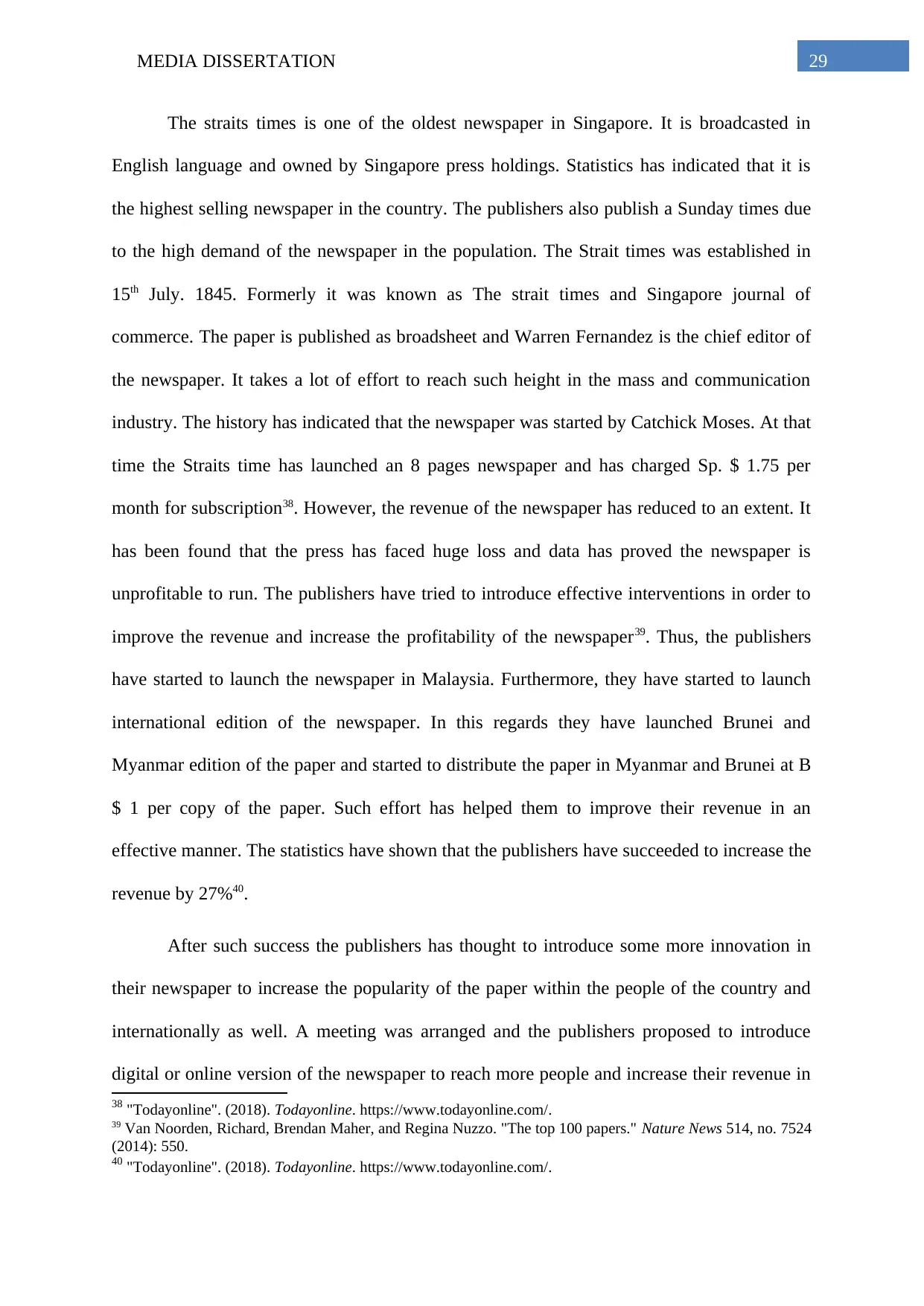
MEDIA DISSERTATION 29
The straits times is one of the oldest newspaper in Singapore. It is broadcasted in
English language and owned by Singapore press holdings. Statistics has indicated that it is
the highest selling newspaper in the country. The publishers also publish a Sunday times due
to the high demand of the newspaper in the population. The Strait times was established in
15th July. 1845. Formerly it was known as The strait times and Singapore journal of
commerce. The paper is published as broadsheet and Warren Fernandez is the chief editor of
the newspaper. It takes a lot of effort to reach such height in the mass and communication
industry. The history has indicated that the newspaper was started by Catchick Moses. At that
time the Straits time has launched an 8 pages newspaper and has charged Sp. $ 1.75 per
month for subscription38. However, the revenue of the newspaper has reduced to an extent. It
has been found that the press has faced huge loss and data has proved the newspaper is
unprofitable to run. The publishers have tried to introduce effective interventions in order to
improve the revenue and increase the profitability of the newspaper39. Thus, the publishers
have started to launch the newspaper in Malaysia. Furthermore, they have started to launch
international edition of the newspaper. In this regards they have launched Brunei and
Myanmar edition of the paper and started to distribute the paper in Myanmar and Brunei at B
$ 1 per copy of the paper. Such effort has helped them to improve their revenue in an
effective manner. The statistics have shown that the publishers have succeeded to increase the
revenue by 27%40.
After such success the publishers has thought to introduce some more innovation in
their newspaper to increase the popularity of the paper within the people of the country and
internationally as well. A meeting was arranged and the publishers proposed to introduce
digital or online version of the newspaper to reach more people and increase their revenue in
38 "Todayonline". (2018). Todayonline. https://www.todayonline.com/.
39 Van Noorden, Richard, Brendan Maher, and Regina Nuzzo. "The top 100 papers." Nature News 514, no. 7524
(2014): 550.
40 "Todayonline". (2018). Todayonline. https://www.todayonline.com/.
The straits times is one of the oldest newspaper in Singapore. It is broadcasted in
English language and owned by Singapore press holdings. Statistics has indicated that it is
the highest selling newspaper in the country. The publishers also publish a Sunday times due
to the high demand of the newspaper in the population. The Strait times was established in
15th July. 1845. Formerly it was known as The strait times and Singapore journal of
commerce. The paper is published as broadsheet and Warren Fernandez is the chief editor of
the newspaper. It takes a lot of effort to reach such height in the mass and communication
industry. The history has indicated that the newspaper was started by Catchick Moses. At that
time the Straits time has launched an 8 pages newspaper and has charged Sp. $ 1.75 per
month for subscription38. However, the revenue of the newspaper has reduced to an extent. It
has been found that the press has faced huge loss and data has proved the newspaper is
unprofitable to run. The publishers have tried to introduce effective interventions in order to
improve the revenue and increase the profitability of the newspaper39. Thus, the publishers
have started to launch the newspaper in Malaysia. Furthermore, they have started to launch
international edition of the newspaper. In this regards they have launched Brunei and
Myanmar edition of the paper and started to distribute the paper in Myanmar and Brunei at B
$ 1 per copy of the paper. Such effort has helped them to improve their revenue in an
effective manner. The statistics have shown that the publishers have succeeded to increase the
revenue by 27%40.
After such success the publishers has thought to introduce some more innovation in
their newspaper to increase the popularity of the paper within the people of the country and
internationally as well. A meeting was arranged and the publishers proposed to introduce
digital or online version of the newspaper to reach more people and increase their revenue in
38 "Todayonline". (2018). Todayonline. https://www.todayonline.com/.
39 Van Noorden, Richard, Brendan Maher, and Regina Nuzzo. "The top 100 papers." Nature News 514, no. 7524
(2014): 550.
40 "Todayonline". (2018). Todayonline. https://www.todayonline.com/.
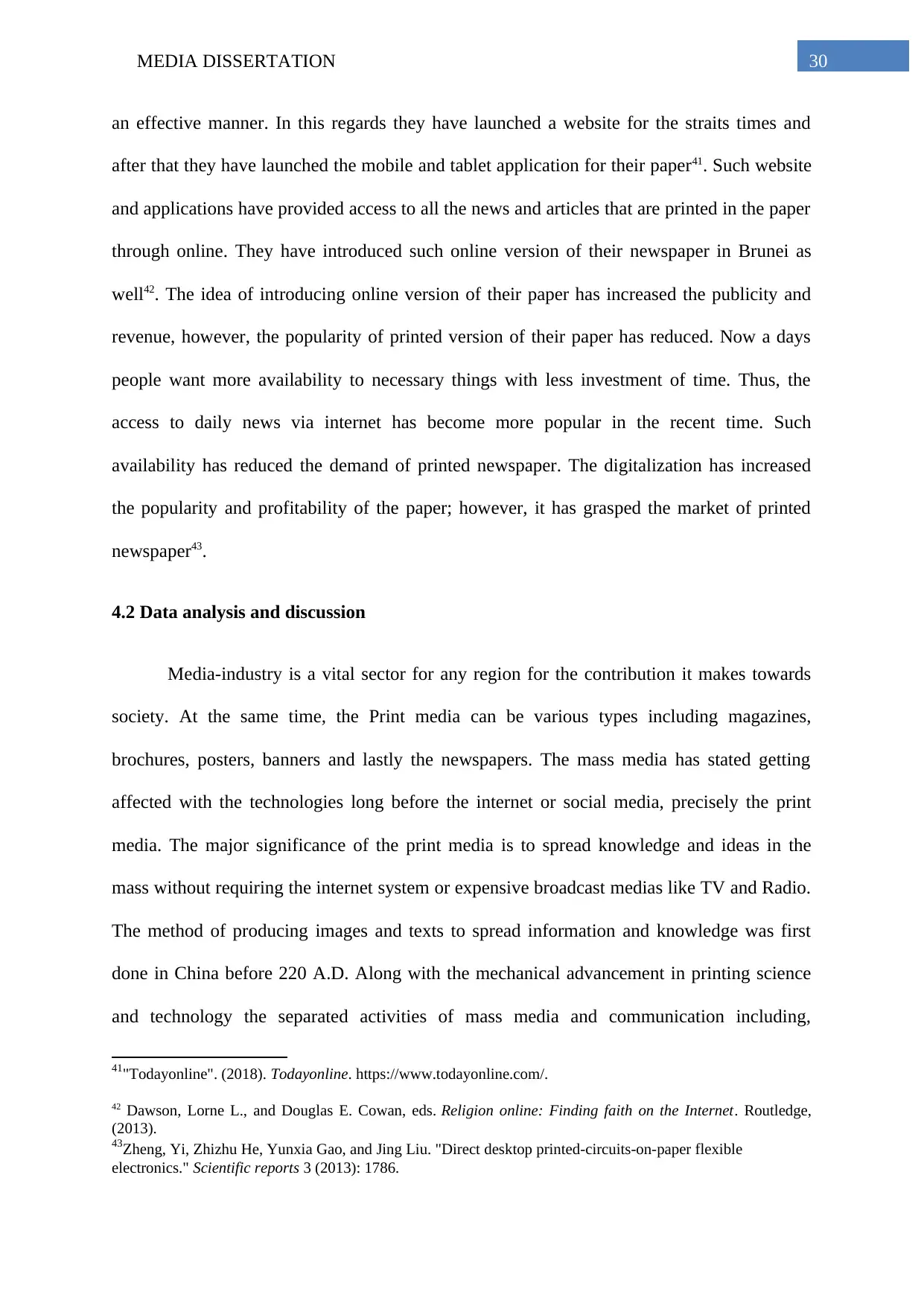
MEDIA DISSERTATION 30
an effective manner. In this regards they have launched a website for the straits times and
after that they have launched the mobile and tablet application for their paper41. Such website
and applications have provided access to all the news and articles that are printed in the paper
through online. They have introduced such online version of their newspaper in Brunei as
well42. The idea of introducing online version of their paper has increased the publicity and
revenue, however, the popularity of printed version of their paper has reduced. Now a days
people want more availability to necessary things with less investment of time. Thus, the
access to daily news via internet has become more popular in the recent time. Such
availability has reduced the demand of printed newspaper. The digitalization has increased
the popularity and profitability of the paper; however, it has grasped the market of printed
newspaper43.
4.2 Data analysis and discussion
Media-industry is a vital sector for any region for the contribution it makes towards
society. At the same time, the Print media can be various types including magazines,
brochures, posters, banners and lastly the newspapers. The mass media has stated getting
affected with the technologies long before the internet or social media, precisely the print
media. The major significance of the print media is to spread knowledge and ideas in the
mass without requiring the internet system or expensive broadcast medias like TV and Radio.
The method of producing images and texts to spread information and knowledge was first
done in China before 220 A.D. Along with the mechanical advancement in printing science
and technology the separated activities of mass media and communication including,
41"Todayonline". (2018). Todayonline. https://www.todayonline.com/.
42 Dawson, Lorne L., and Douglas E. Cowan, eds. Religion online: Finding faith on the Internet. Routledge,
(2013).
43Zheng, Yi, Zhizhu He, Yunxia Gao, and Jing Liu. "Direct desktop printed-circuits-on-paper flexible
electronics." Scientific reports 3 (2013): 1786.
an effective manner. In this regards they have launched a website for the straits times and
after that they have launched the mobile and tablet application for their paper41. Such website
and applications have provided access to all the news and articles that are printed in the paper
through online. They have introduced such online version of their newspaper in Brunei as
well42. The idea of introducing online version of their paper has increased the publicity and
revenue, however, the popularity of printed version of their paper has reduced. Now a days
people want more availability to necessary things with less investment of time. Thus, the
access to daily news via internet has become more popular in the recent time. Such
availability has reduced the demand of printed newspaper. The digitalization has increased
the popularity and profitability of the paper; however, it has grasped the market of printed
newspaper43.
4.2 Data analysis and discussion
Media-industry is a vital sector for any region for the contribution it makes towards
society. At the same time, the Print media can be various types including magazines,
brochures, posters, banners and lastly the newspapers. The mass media has stated getting
affected with the technologies long before the internet or social media, precisely the print
media. The major significance of the print media is to spread knowledge and ideas in the
mass without requiring the internet system or expensive broadcast medias like TV and Radio.
The method of producing images and texts to spread information and knowledge was first
done in China before 220 A.D. Along with the mechanical advancement in printing science
and technology the separated activities of mass media and communication including,
41"Todayonline". (2018). Todayonline. https://www.todayonline.com/.
42 Dawson, Lorne L., and Douglas E. Cowan, eds. Religion online: Finding faith on the Internet. Routledge,
(2013).
43Zheng, Yi, Zhizhu He, Yunxia Gao, and Jing Liu. "Direct desktop printed-circuits-on-paper flexible
electronics." Scientific reports 3 (2013): 1786.
Paraphrase This Document
Need a fresh take? Get an instant paraphrase of this document with our AI Paraphraser
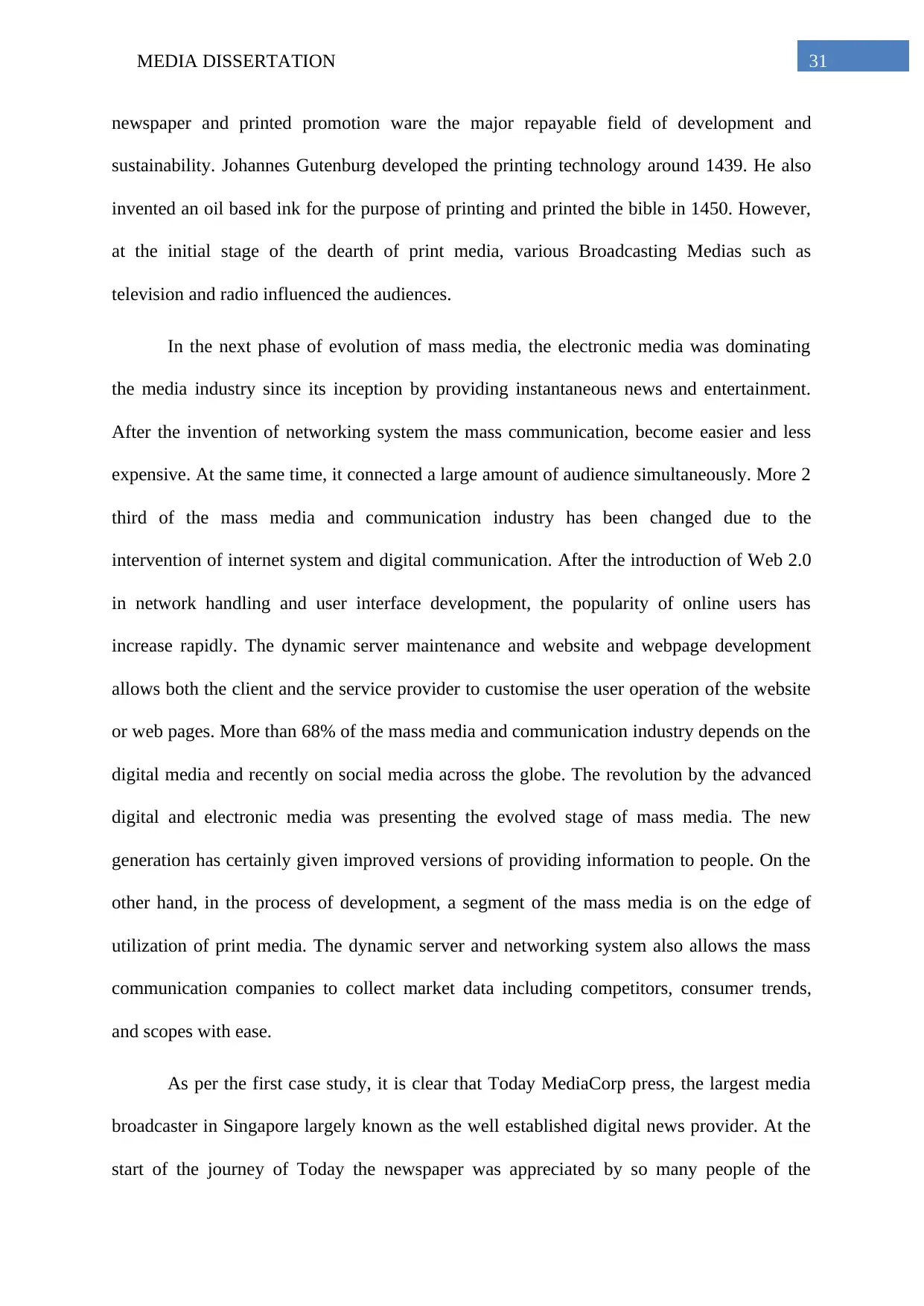
MEDIA DISSERTATION 31
newspaper and printed promotion ware the major repayable field of development and
sustainability. Johannes Gutenburg developed the printing technology around 1439. He also
invented an oil based ink for the purpose of printing and printed the bible in 1450. However,
at the initial stage of the dearth of print media, various Broadcasting Medias such as
television and radio influenced the audiences.
In the next phase of evolution of mass media, the electronic media was dominating
the media industry since its inception by providing instantaneous news and entertainment.
After the invention of networking system the mass communication, become easier and less
expensive. At the same time, it connected a large amount of audience simultaneously. More 2
third of the mass media and communication industry has been changed due to the
intervention of internet system and digital communication. After the introduction of Web 2.0
in network handling and user interface development, the popularity of online users has
increase rapidly. The dynamic server maintenance and website and webpage development
allows both the client and the service provider to customise the user operation of the website
or web pages. More than 68% of the mass media and communication industry depends on the
digital media and recently on social media across the globe. The revolution by the advanced
digital and electronic media was presenting the evolved stage of mass media. The new
generation has certainly given improved versions of providing information to people. On the
other hand, in the process of development, a segment of the mass media is on the edge of
utilization of print media. The dynamic server and networking system also allows the mass
communication companies to collect market data including competitors, consumer trends,
and scopes with ease.
As per the first case study, it is clear that Today MediaCorp press, the largest media
broadcaster in Singapore largely known as the well established digital news provider. At the
start of the journey of Today the newspaper was appreciated by so many people of the
newspaper and printed promotion ware the major repayable field of development and
sustainability. Johannes Gutenburg developed the printing technology around 1439. He also
invented an oil based ink for the purpose of printing and printed the bible in 1450. However,
at the initial stage of the dearth of print media, various Broadcasting Medias such as
television and radio influenced the audiences.
In the next phase of evolution of mass media, the electronic media was dominating
the media industry since its inception by providing instantaneous news and entertainment.
After the invention of networking system the mass communication, become easier and less
expensive. At the same time, it connected a large amount of audience simultaneously. More 2
third of the mass media and communication industry has been changed due to the
intervention of internet system and digital communication. After the introduction of Web 2.0
in network handling and user interface development, the popularity of online users has
increase rapidly. The dynamic server maintenance and website and webpage development
allows both the client and the service provider to customise the user operation of the website
or web pages. More than 68% of the mass media and communication industry depends on the
digital media and recently on social media across the globe. The revolution by the advanced
digital and electronic media was presenting the evolved stage of mass media. The new
generation has certainly given improved versions of providing information to people. On the
other hand, in the process of development, a segment of the mass media is on the edge of
utilization of print media. The dynamic server and networking system also allows the mass
communication companies to collect market data including competitors, consumer trends,
and scopes with ease.
As per the first case study, it is clear that Today MediaCorp press, the largest media
broadcaster in Singapore largely known as the well established digital news provider. At the
start of the journey of Today the newspaper was appreciated by so many people of the
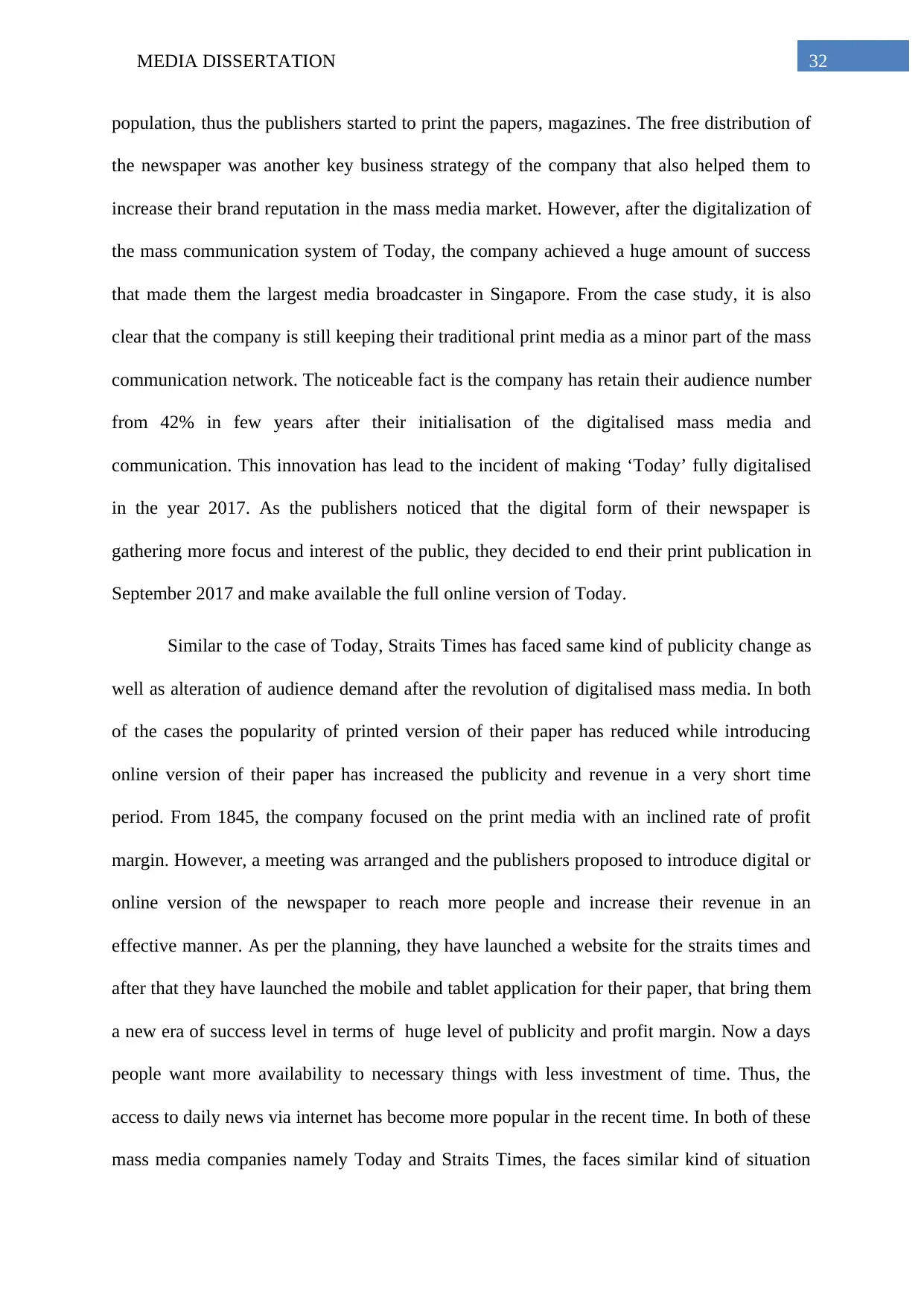
MEDIA DISSERTATION 32
population, thus the publishers started to print the papers, magazines. The free distribution of
the newspaper was another key business strategy of the company that also helped them to
increase their brand reputation in the mass media market. However, after the digitalization of
the mass communication system of Today, the company achieved a huge amount of success
that made them the largest media broadcaster in Singapore. From the case study, it is also
clear that the company is still keeping their traditional print media as a minor part of the mass
communication network. The noticeable fact is the company has retain their audience number
from 42% in few years after their initialisation of the digitalised mass media and
communication. This innovation has lead to the incident of making ‘Today’ fully digitalised
in the year 2017. As the publishers noticed that the digital form of their newspaper is
gathering more focus and interest of the public, they decided to end their print publication in
September 2017 and make available the full online version of Today.
Similar to the case of Today, Straits Times has faced same kind of publicity change as
well as alteration of audience demand after the revolution of digitalised mass media. In both
of the cases the popularity of printed version of their paper has reduced while introducing
online version of their paper has increased the publicity and revenue in a very short time
period. From 1845, the company focused on the print media with an inclined rate of profit
margin. However, a meeting was arranged and the publishers proposed to introduce digital or
online version of the newspaper to reach more people and increase their revenue in an
effective manner. As per the planning, they have launched a website for the straits times and
after that they have launched the mobile and tablet application for their paper, that bring them
a new era of success level in terms of huge level of publicity and profit margin. Now a days
people want more availability to necessary things with less investment of time. Thus, the
access to daily news via internet has become more popular in the recent time. In both of these
mass media companies namely Today and Straits Times, the faces similar kind of situation
population, thus the publishers started to print the papers, magazines. The free distribution of
the newspaper was another key business strategy of the company that also helped them to
increase their brand reputation in the mass media market. However, after the digitalization of
the mass communication system of Today, the company achieved a huge amount of success
that made them the largest media broadcaster in Singapore. From the case study, it is also
clear that the company is still keeping their traditional print media as a minor part of the mass
communication network. The noticeable fact is the company has retain their audience number
from 42% in few years after their initialisation of the digitalised mass media and
communication. This innovation has lead to the incident of making ‘Today’ fully digitalised
in the year 2017. As the publishers noticed that the digital form of their newspaper is
gathering more focus and interest of the public, they decided to end their print publication in
September 2017 and make available the full online version of Today.
Similar to the case of Today, Straits Times has faced same kind of publicity change as
well as alteration of audience demand after the revolution of digitalised mass media. In both
of the cases the popularity of printed version of their paper has reduced while introducing
online version of their paper has increased the publicity and revenue in a very short time
period. From 1845, the company focused on the print media with an inclined rate of profit
margin. However, a meeting was arranged and the publishers proposed to introduce digital or
online version of the newspaper to reach more people and increase their revenue in an
effective manner. As per the planning, they have launched a website for the straits times and
after that they have launched the mobile and tablet application for their paper, that bring them
a new era of success level in terms of huge level of publicity and profit margin. Now a days
people want more availability to necessary things with less investment of time. Thus, the
access to daily news via internet has become more popular in the recent time. In both of these
mass media companies namely Today and Straits Times, the faces similar kind of situation

MEDIA DISSERTATION 33
after the intervention of digital media. At the same time they achieved their success level
after the alteration with their mass media communication strategy prioritising the digital
media based communication. The incorporation of social media is another phase of
development that can bring more success to them as per the market analysis and the trends of
the audiences.
Chapter 5: Conclusion
5.1 Conclusion
Media-industry is a vital sector for any region for the contribution it makes towards
society. The paper printing has been introduced long before its utilisation as mass media
through the process of publishing literature and artworks. Apart from that, the print media
had also been used for marketing and promotional activities in form of flyers, posters and
other forms. The printing press was the only instrument of production that was used to
produce millions of copies of newspaper, flyers, books and magazines. The primary
significance of the print media is to spread knowledge and ideas in the mass without
additional requirement in terms of internet system or satellite broadcast. The initial stages of
print media were influenced by developed machinery followed by electronic media such as
television and radio. However, from the beginning of the digital technological revolution the
scenario began to change quickly. Readers have been becoming more depended on Online
Website, Internet system, cloud network, E-news, E-promotion and other digital media based
technological advancements. With the intervention of Web 2.0, the internet based mass media
and communication entered a new era of establishment. Today to 76% of global mass media
industry depends on the digital media and the percentage is increasing day by day.
after the intervention of digital media. At the same time they achieved their success level
after the alteration with their mass media communication strategy prioritising the digital
media based communication. The incorporation of social media is another phase of
development that can bring more success to them as per the market analysis and the trends of
the audiences.
Chapter 5: Conclusion
5.1 Conclusion
Media-industry is a vital sector for any region for the contribution it makes towards
society. The paper printing has been introduced long before its utilisation as mass media
through the process of publishing literature and artworks. Apart from that, the print media
had also been used for marketing and promotional activities in form of flyers, posters and
other forms. The printing press was the only instrument of production that was used to
produce millions of copies of newspaper, flyers, books and magazines. The primary
significance of the print media is to spread knowledge and ideas in the mass without
additional requirement in terms of internet system or satellite broadcast. The initial stages of
print media were influenced by developed machinery followed by electronic media such as
television and radio. However, from the beginning of the digital technological revolution the
scenario began to change quickly. Readers have been becoming more depended on Online
Website, Internet system, cloud network, E-news, E-promotion and other digital media based
technological advancements. With the intervention of Web 2.0, the internet based mass media
and communication entered a new era of establishment. Today to 76% of global mass media
industry depends on the digital media and the percentage is increasing day by day.
Secure Best Marks with AI Grader
Need help grading? Try our AI Grader for instant feedback on your assignments.
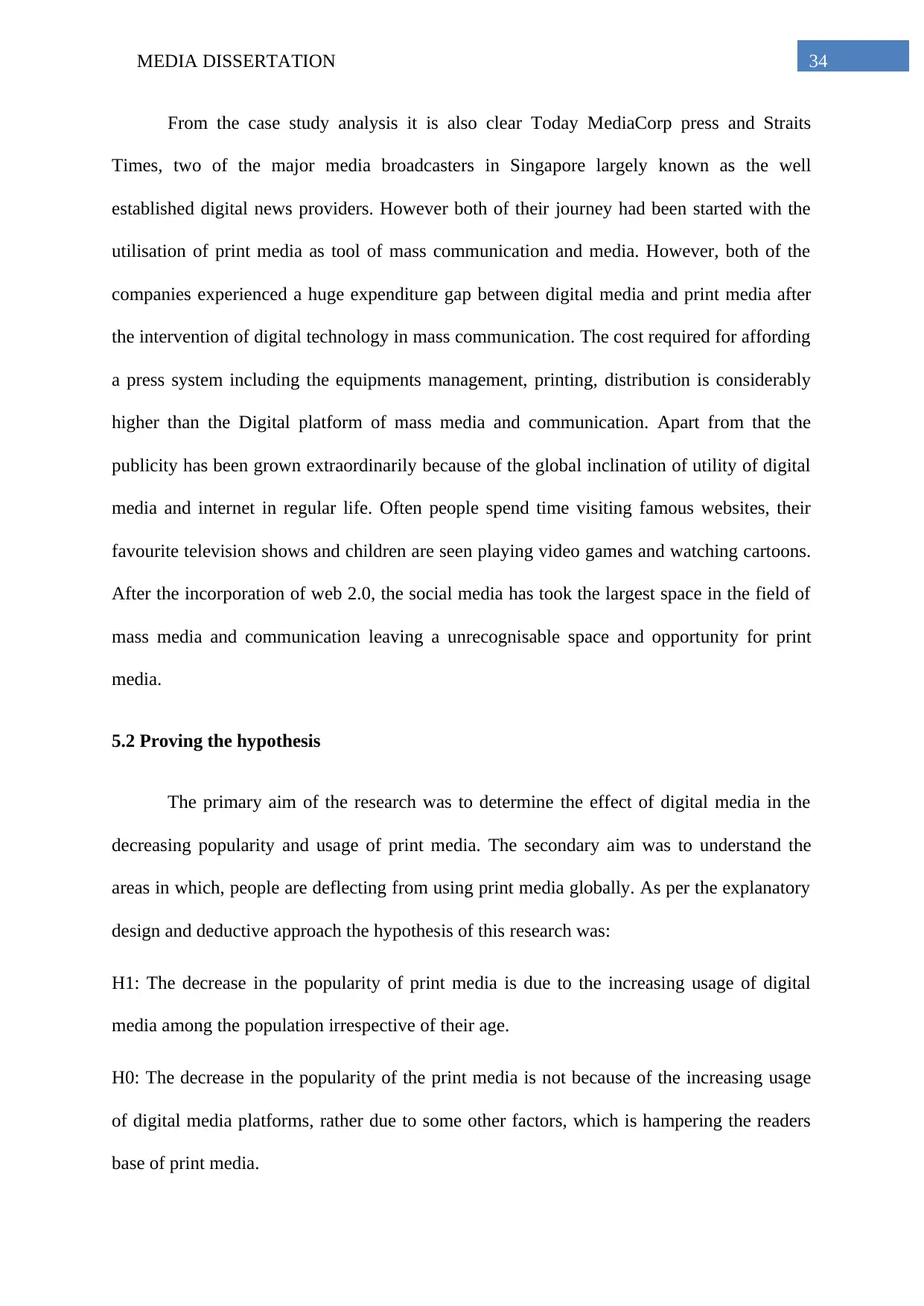
MEDIA DISSERTATION 34
From the case study analysis it is also clear Today MediaCorp press and Straits
Times, two of the major media broadcasters in Singapore largely known as the well
established digital news providers. However both of their journey had been started with the
utilisation of print media as tool of mass communication and media. However, both of the
companies experienced a huge expenditure gap between digital media and print media after
the intervention of digital technology in mass communication. The cost required for affording
a press system including the equipments management, printing, distribution is considerably
higher than the Digital platform of mass media and communication. Apart from that the
publicity has been grown extraordinarily because of the global inclination of utility of digital
media and internet in regular life. Often people spend time visiting famous websites, their
favourite television shows and children are seen playing video games and watching cartoons.
After the incorporation of web 2.0, the social media has took the largest space in the field of
mass media and communication leaving a unrecognisable space and opportunity for print
media.
5.2 Proving the hypothesis
The primary aim of the research was to determine the effect of digital media in the
decreasing popularity and usage of print media. The secondary aim was to understand the
areas in which, people are deflecting from using print media globally. As per the explanatory
design and deductive approach the hypothesis of this research was:
H1: The decrease in the popularity of print media is due to the increasing usage of digital
media among the population irrespective of their age.
H0: The decrease in the popularity of the print media is not because of the increasing usage
of digital media platforms, rather due to some other factors, which is hampering the readers
base of print media.
From the case study analysis it is also clear Today MediaCorp press and Straits
Times, two of the major media broadcasters in Singapore largely known as the well
established digital news providers. However both of their journey had been started with the
utilisation of print media as tool of mass communication and media. However, both of the
companies experienced a huge expenditure gap between digital media and print media after
the intervention of digital technology in mass communication. The cost required for affording
a press system including the equipments management, printing, distribution is considerably
higher than the Digital platform of mass media and communication. Apart from that the
publicity has been grown extraordinarily because of the global inclination of utility of digital
media and internet in regular life. Often people spend time visiting famous websites, their
favourite television shows and children are seen playing video games and watching cartoons.
After the incorporation of web 2.0, the social media has took the largest space in the field of
mass media and communication leaving a unrecognisable space and opportunity for print
media.
5.2 Proving the hypothesis
The primary aim of the research was to determine the effect of digital media in the
decreasing popularity and usage of print media. The secondary aim was to understand the
areas in which, people are deflecting from using print media globally. As per the explanatory
design and deductive approach the hypothesis of this research was:
H1: The decrease in the popularity of print media is due to the increasing usage of digital
media among the population irrespective of their age.
H0: The decrease in the popularity of the print media is not because of the increasing usage
of digital media platforms, rather due to some other factors, which is hampering the readers
base of print media.

MEDIA DISSERTATION 35
From the above case study and other secondary analysis and discussion, it has been
proven that because of the cost efficiency for the companies and the acceptability within the
modern lifestyle the mass media and communication industry is becoming more and more
dependent on the digital media and advanced digitalization, which is social media. It has been
also proven that even after the intervention of broadcast media, the print media was still able
to hold its place to some extent. However, after the digital media, it has took the largest space
in the field of mass media and communication industry leaving a unrecognisable scop for
print media. Therefore, it is clearly indicating that the reason behind the dearth of print media
is the dependency on digitalization and the popularity of digital media. Therefore the
hypothesis of this study has been proven successfully.
5.4 Limitation
Limitations of a research are situations, which are not under control of the researchers
and created a future prospect for the research study. This research was completely based on
the secondary statistical data and figures collected from different newspaper organizations
and did not included any primary data such as interviews or surveys with the employees or
readers of such news papers. Therefore, it affected the credibility of the research. Further, the
second limitation can be the broad prospect of the research due to which focusing on crucial
and important factor that lead print media lost its reputation becomes difficult. Therefore,
broader aspect of research can be the second limitation of this research study. Apart from
that the literature review has been focused only the benefit of digital media over print media,
instead of discussing the further possible consequences due to the ultimate collapse of print
media.
From the above case study and other secondary analysis and discussion, it has been
proven that because of the cost efficiency for the companies and the acceptability within the
modern lifestyle the mass media and communication industry is becoming more and more
dependent on the digital media and advanced digitalization, which is social media. It has been
also proven that even after the intervention of broadcast media, the print media was still able
to hold its place to some extent. However, after the digital media, it has took the largest space
in the field of mass media and communication industry leaving a unrecognisable scop for
print media. Therefore, it is clearly indicating that the reason behind the dearth of print media
is the dependency on digitalization and the popularity of digital media. Therefore the
hypothesis of this study has been proven successfully.
5.4 Limitation
Limitations of a research are situations, which are not under control of the researchers
and created a future prospect for the research study. This research was completely based on
the secondary statistical data and figures collected from different newspaper organizations
and did not included any primary data such as interviews or surveys with the employees or
readers of such news papers. Therefore, it affected the credibility of the research. Further, the
second limitation can be the broad prospect of the research due to which focusing on crucial
and important factor that lead print media lost its reputation becomes difficult. Therefore,
broader aspect of research can be the second limitation of this research study. Apart from
that the literature review has been focused only the benefit of digital media over print media,
instead of discussing the further possible consequences due to the ultimate collapse of print
media.
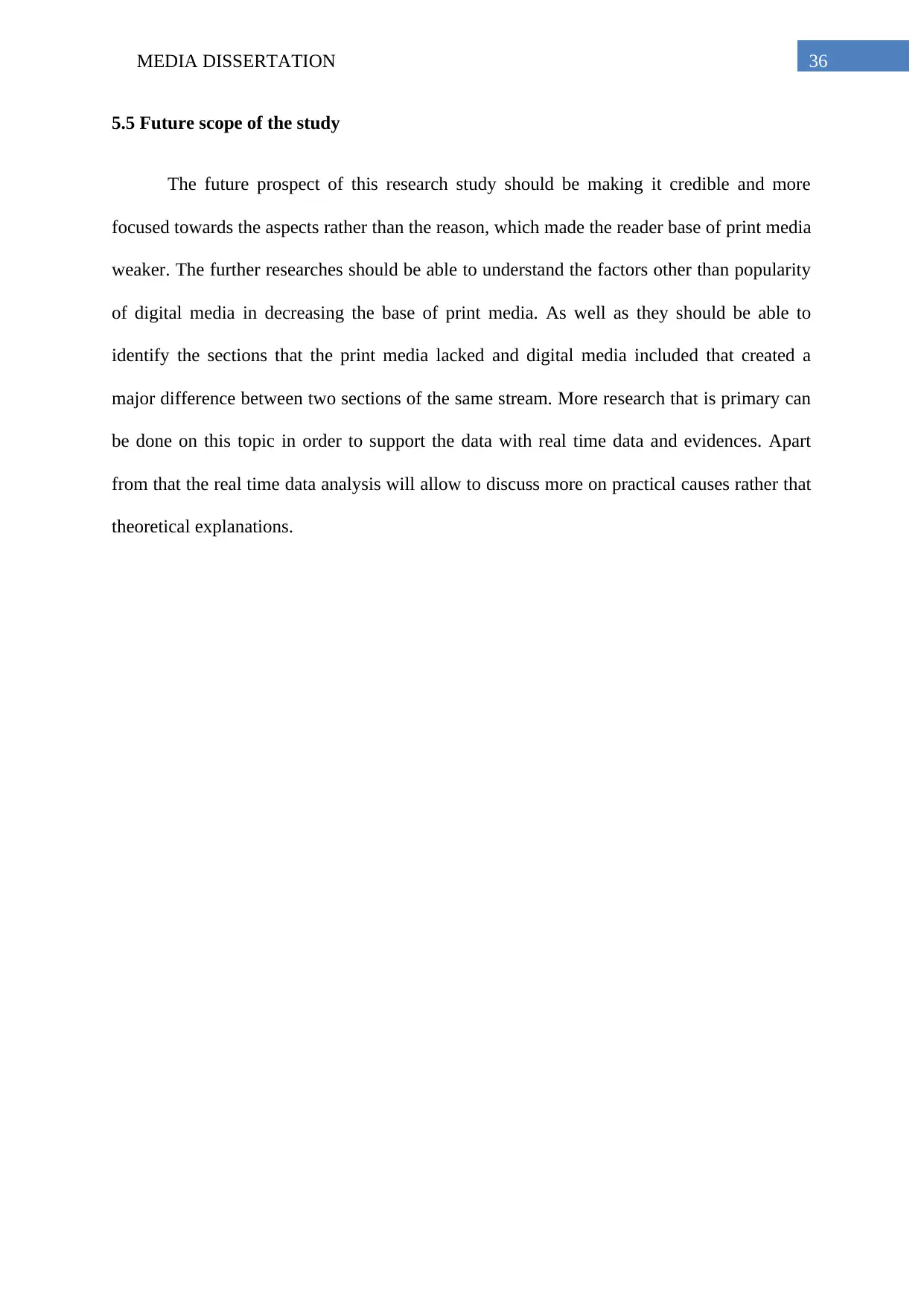
MEDIA DISSERTATION 36
5.5 Future scope of the study
The future prospect of this research study should be making it credible and more
focused towards the aspects rather than the reason, which made the reader base of print media
weaker. The further researches should be able to understand the factors other than popularity
of digital media in decreasing the base of print media. As well as they should be able to
identify the sections that the print media lacked and digital media included that created a
major difference between two sections of the same stream. More research that is primary can
be done on this topic in order to support the data with real time data and evidences. Apart
from that the real time data analysis will allow to discuss more on practical causes rather that
theoretical explanations.
5.5 Future scope of the study
The future prospect of this research study should be making it credible and more
focused towards the aspects rather than the reason, which made the reader base of print media
weaker. The further researches should be able to understand the factors other than popularity
of digital media in decreasing the base of print media. As well as they should be able to
identify the sections that the print media lacked and digital media included that created a
major difference between two sections of the same stream. More research that is primary can
be done on this topic in order to support the data with real time data and evidences. Apart
from that the real time data analysis will allow to discuss more on practical causes rather that
theoretical explanations.
Paraphrase This Document
Need a fresh take? Get an instant paraphrase of this document with our AI Paraphraser
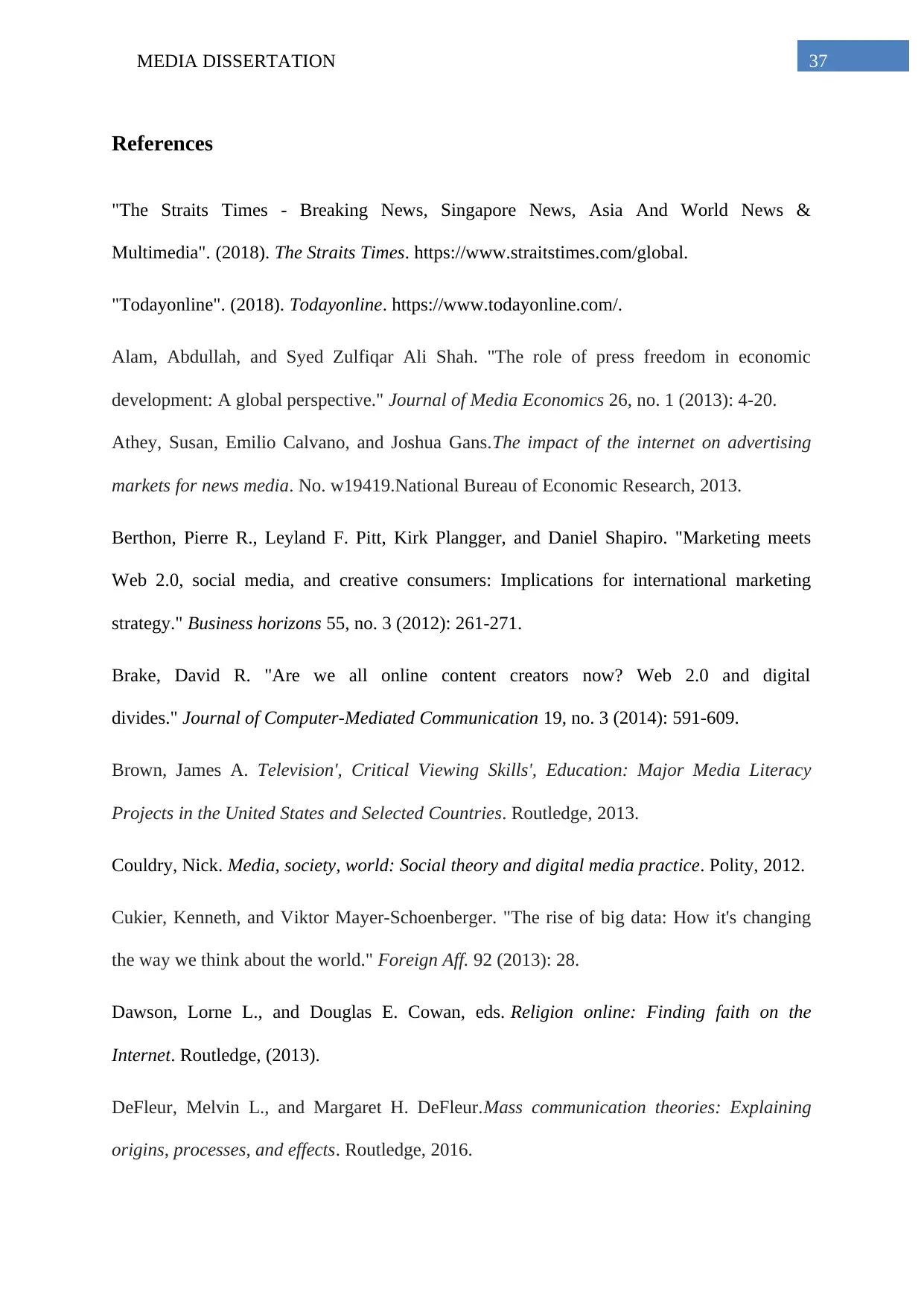
MEDIA DISSERTATION 37
References
"The Straits Times - Breaking News, Singapore News, Asia And World News &
Multimedia". (2018). The Straits Times. https://www.straitstimes.com/global.
"Todayonline". (2018). Todayonline. https://www.todayonline.com/.
Alam, Abdullah, and Syed Zulfiqar Ali Shah. "The role of press freedom in economic
development: A global perspective." Journal of Media Economics 26, no. 1 (2013): 4-20.
Athey, Susan, Emilio Calvano, and Joshua Gans.The impact of the internet on advertising
markets for news media. No. w19419.National Bureau of Economic Research, 2013.
Berthon, Pierre R., Leyland F. Pitt, Kirk Plangger, and Daniel Shapiro. "Marketing meets
Web 2.0, social media, and creative consumers: Implications for international marketing
strategy." Business horizons 55, no. 3 (2012): 261-271.
Brake, David R. "Are we all online content creators now? Web 2.0 and digital
divides." Journal of Computer-Mediated Communication 19, no. 3 (2014): 591-609.
Brown, James A. Television', Critical Viewing Skills', Education: Major Media Literacy
Projects in the United States and Selected Countries. Routledge, 2013.
Couldry, Nick. Media, society, world: Social theory and digital media practice. Polity, 2012.
Cukier, Kenneth, and Viktor Mayer-Schoenberger. "The rise of big data: How it's changing
the way we think about the world." Foreign Aff. 92 (2013): 28.
Dawson, Lorne L., and Douglas E. Cowan, eds. Religion online: Finding faith on the
Internet. Routledge, (2013).
DeFleur, Melvin L., and Margaret H. DeFleur.Mass communication theories: Explaining
origins, processes, and effects. Routledge, 2016.
References
"The Straits Times - Breaking News, Singapore News, Asia And World News &
Multimedia". (2018). The Straits Times. https://www.straitstimes.com/global.
"Todayonline". (2018). Todayonline. https://www.todayonline.com/.
Alam, Abdullah, and Syed Zulfiqar Ali Shah. "The role of press freedom in economic
development: A global perspective." Journal of Media Economics 26, no. 1 (2013): 4-20.
Athey, Susan, Emilio Calvano, and Joshua Gans.The impact of the internet on advertising
markets for news media. No. w19419.National Bureau of Economic Research, 2013.
Berthon, Pierre R., Leyland F. Pitt, Kirk Plangger, and Daniel Shapiro. "Marketing meets
Web 2.0, social media, and creative consumers: Implications for international marketing
strategy." Business horizons 55, no. 3 (2012): 261-271.
Brake, David R. "Are we all online content creators now? Web 2.0 and digital
divides." Journal of Computer-Mediated Communication 19, no. 3 (2014): 591-609.
Brown, James A. Television', Critical Viewing Skills', Education: Major Media Literacy
Projects in the United States and Selected Countries. Routledge, 2013.
Couldry, Nick. Media, society, world: Social theory and digital media practice. Polity, 2012.
Cukier, Kenneth, and Viktor Mayer-Schoenberger. "The rise of big data: How it's changing
the way we think about the world." Foreign Aff. 92 (2013): 28.
Dawson, Lorne L., and Douglas E. Cowan, eds. Religion online: Finding faith on the
Internet. Routledge, (2013).
DeFleur, Melvin L., and Margaret H. DeFleur.Mass communication theories: Explaining
origins, processes, and effects. Routledge, 2016.

MEDIA DISSERTATION 38
Doyle, Gillian. "Re-invention and survival: newspapers in the era of digital multiplatform
delivery." Journal of Media Business Studies 10, no. 4 (2013): 1-20.
Flick, Uwe. Introducing research methodology: A beginner's guide to doing a research
project. Sage, 2015.
Happer, Catherine, and Greg Philo."The role of the media in the construction of public belief
and social change."Journal of social and political psychology 1, no. 1 (2013): 321-336.
Hsia, Hower J. Mass communications research methods: A step-by-step approach.
Routledge, 2015.
Karimi, Jahangir, and Zhiping Walter. "The role of dynamic capabilities in responding to
digital disruption: A factor-based study of the newspaper industry." Journal of Management
Information Systems 32, no. 1 (2015): 39-81.
Lewis, Sarah. "Qualitative inquiry and research design: Choosing among five
approaches." Health promotion practice16, no. 4 (2015): 473-475.
Loosen, Wiebke, and Jan-Hinrik Schmidt. "(Re-) discovering the audience: The relationship
between journalism and audience in networked digital media." Information, Communication
& Society 15, no. 6 (2012): 867-887.
Mangen, Anne, Bente R. Walgermo, and Kolbjørn Brønnick. "Reading linear texts on paper
versus computer screen: Effects on reading comprehension." International journal of
educational research 58 (2013): 61-68.
McNair, Brian. An introduction to political communication.Routledge, 2017.
Mulhern, Frank. "Integrated marketing communications: From media channels to digital
connectivity." In The Evolution of Integrated Marketing Communications, pp. 19-36.
Routledge, 2013.
Doyle, Gillian. "Re-invention and survival: newspapers in the era of digital multiplatform
delivery." Journal of Media Business Studies 10, no. 4 (2013): 1-20.
Flick, Uwe. Introducing research methodology: A beginner's guide to doing a research
project. Sage, 2015.
Happer, Catherine, and Greg Philo."The role of the media in the construction of public belief
and social change."Journal of social and political psychology 1, no. 1 (2013): 321-336.
Hsia, Hower J. Mass communications research methods: A step-by-step approach.
Routledge, 2015.
Karimi, Jahangir, and Zhiping Walter. "The role of dynamic capabilities in responding to
digital disruption: A factor-based study of the newspaper industry." Journal of Management
Information Systems 32, no. 1 (2015): 39-81.
Lewis, Sarah. "Qualitative inquiry and research design: Choosing among five
approaches." Health promotion practice16, no. 4 (2015): 473-475.
Loosen, Wiebke, and Jan-Hinrik Schmidt. "(Re-) discovering the audience: The relationship
between journalism and audience in networked digital media." Information, Communication
& Society 15, no. 6 (2012): 867-887.
Mangen, Anne, Bente R. Walgermo, and Kolbjørn Brønnick. "Reading linear texts on paper
versus computer screen: Effects on reading comprehension." International journal of
educational research 58 (2013): 61-68.
McNair, Brian. An introduction to political communication.Routledge, 2017.
Mulhern, Frank. "Integrated marketing communications: From media channels to digital
connectivity." In The Evolution of Integrated Marketing Communications, pp. 19-36.
Routledge, 2013.
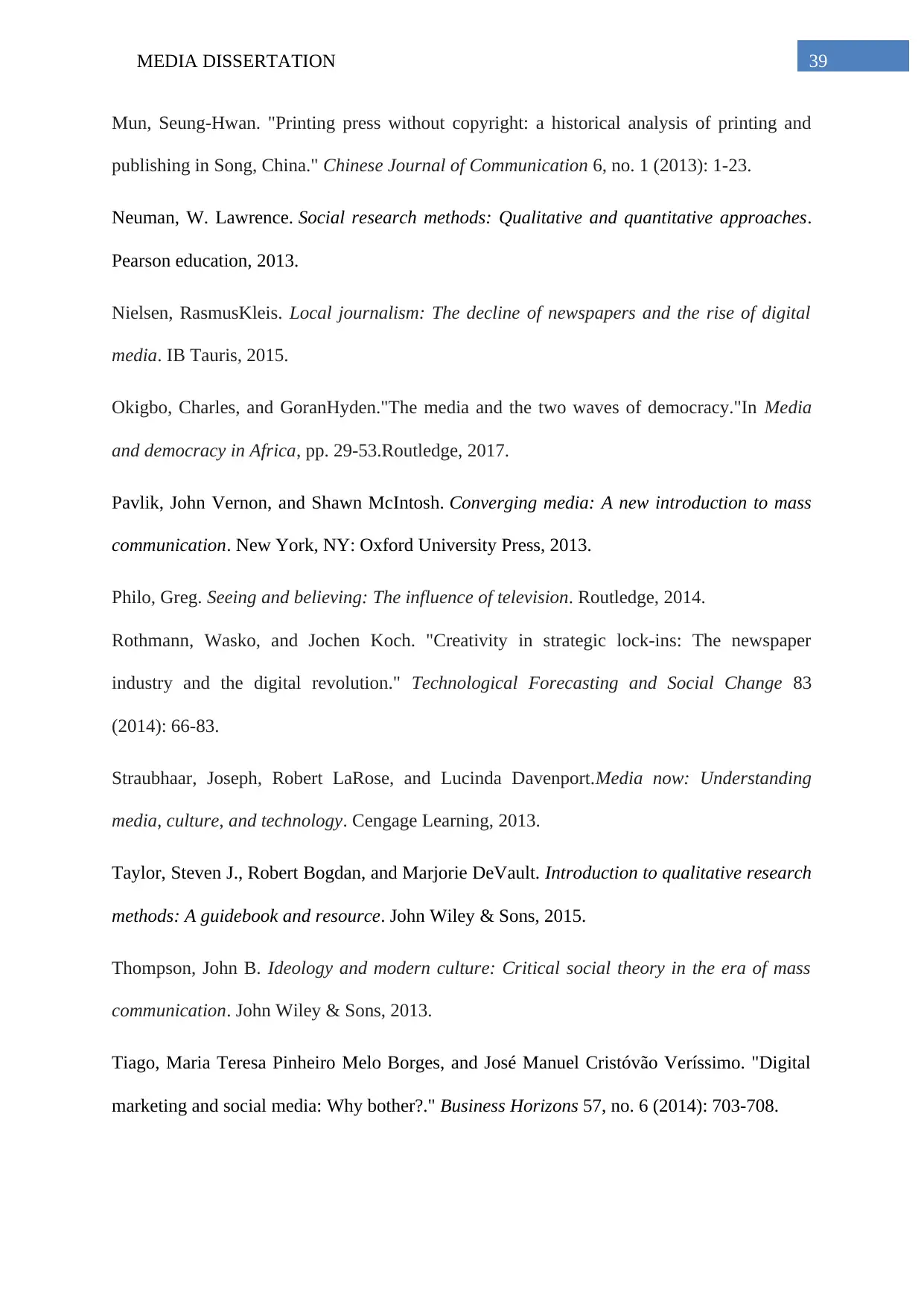
MEDIA DISSERTATION 39
Mun, Seung-Hwan. "Printing press without copyright: a historical analysis of printing and
publishing in Song, China." Chinese Journal of Communication 6, no. 1 (2013): 1-23.
Neuman, W. Lawrence. Social research methods: Qualitative and quantitative approaches.
Pearson education, 2013.
Nielsen, RasmusKleis. Local journalism: The decline of newspapers and the rise of digital
media. IB Tauris, 2015.
Okigbo, Charles, and GoranHyden."The media and the two waves of democracy."In Media
and democracy in Africa, pp. 29-53.Routledge, 2017.
Pavlik, John Vernon, and Shawn McIntosh. Converging media: A new introduction to mass
communication. New York, NY: Oxford University Press, 2013.
Philo, Greg. Seeing and believing: The influence of television. Routledge, 2014.
Rothmann, Wasko, and Jochen Koch. "Creativity in strategic lock-ins: The newspaper
industry and the digital revolution." Technological Forecasting and Social Change 83
(2014): 66-83.
Straubhaar, Joseph, Robert LaRose, and Lucinda Davenport.Media now: Understanding
media, culture, and technology. Cengage Learning, 2013.
Taylor, Steven J., Robert Bogdan, and Marjorie DeVault. Introduction to qualitative research
methods: A guidebook and resource. John Wiley & Sons, 2015.
Thompson, John B. Ideology and modern culture: Critical social theory in the era of mass
communication. John Wiley & Sons, 2013.
Tiago, Maria Teresa Pinheiro Melo Borges, and José Manuel Cristóvão Veríssimo. "Digital
marketing and social media: Why bother?." Business Horizons 57, no. 6 (2014): 703-708.
Mun, Seung-Hwan. "Printing press without copyright: a historical analysis of printing and
publishing in Song, China." Chinese Journal of Communication 6, no. 1 (2013): 1-23.
Neuman, W. Lawrence. Social research methods: Qualitative and quantitative approaches.
Pearson education, 2013.
Nielsen, RasmusKleis. Local journalism: The decline of newspapers and the rise of digital
media. IB Tauris, 2015.
Okigbo, Charles, and GoranHyden."The media and the two waves of democracy."In Media
and democracy in Africa, pp. 29-53.Routledge, 2017.
Pavlik, John Vernon, and Shawn McIntosh. Converging media: A new introduction to mass
communication. New York, NY: Oxford University Press, 2013.
Philo, Greg. Seeing and believing: The influence of television. Routledge, 2014.
Rothmann, Wasko, and Jochen Koch. "Creativity in strategic lock-ins: The newspaper
industry and the digital revolution." Technological Forecasting and Social Change 83
(2014): 66-83.
Straubhaar, Joseph, Robert LaRose, and Lucinda Davenport.Media now: Understanding
media, culture, and technology. Cengage Learning, 2013.
Taylor, Steven J., Robert Bogdan, and Marjorie DeVault. Introduction to qualitative research
methods: A guidebook and resource. John Wiley & Sons, 2015.
Thompson, John B. Ideology and modern culture: Critical social theory in the era of mass
communication. John Wiley & Sons, 2013.
Tiago, Maria Teresa Pinheiro Melo Borges, and José Manuel Cristóvão Veríssimo. "Digital
marketing and social media: Why bother?." Business Horizons 57, no. 6 (2014): 703-708.
Secure Best Marks with AI Grader
Need help grading? Try our AI Grader for instant feedback on your assignments.
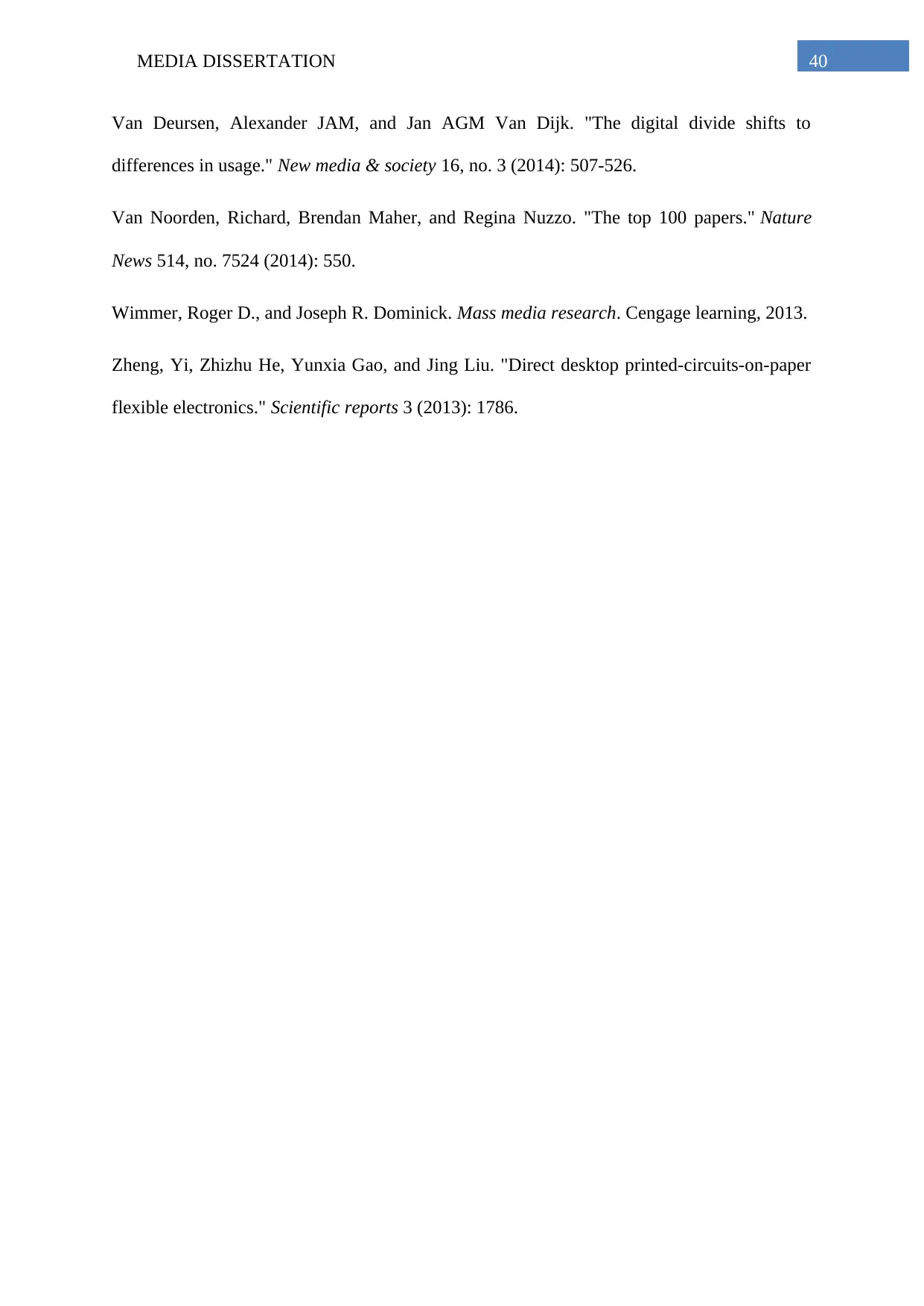
MEDIA DISSERTATION 40
Van Deursen, Alexander JAM, and Jan AGM Van Dijk. "The digital divide shifts to
differences in usage." New media & society 16, no. 3 (2014): 507-526.
Van Noorden, Richard, Brendan Maher, and Regina Nuzzo. "The top 100 papers." Nature
News 514, no. 7524 (2014): 550.
Wimmer, Roger D., and Joseph R. Dominick. Mass media research. Cengage learning, 2013.
Zheng, Yi, Zhizhu He, Yunxia Gao, and Jing Liu. "Direct desktop printed-circuits-on-paper
flexible electronics." Scientific reports 3 (2013): 1786.
Van Deursen, Alexander JAM, and Jan AGM Van Dijk. "The digital divide shifts to
differences in usage." New media & society 16, no. 3 (2014): 507-526.
Van Noorden, Richard, Brendan Maher, and Regina Nuzzo. "The top 100 papers." Nature
News 514, no. 7524 (2014): 550.
Wimmer, Roger D., and Joseph R. Dominick. Mass media research. Cengage learning, 2013.
Zheng, Yi, Zhizhu He, Yunxia Gao, and Jing Liu. "Direct desktop printed-circuits-on-paper
flexible electronics." Scientific reports 3 (2013): 1786.
1 out of 41
Related Documents
Your All-in-One AI-Powered Toolkit for Academic Success.
+13062052269
info@desklib.com
Available 24*7 on WhatsApp / Email
![[object Object]](/_next/static/media/star-bottom.7253800d.svg)
Unlock your academic potential
© 2024 | Zucol Services PVT LTD | All rights reserved.





